MARCH MEETING, 1916
A Stated Meeting of the Society was held at the house of the American Academy of Arts and Sciences, No. 28 Newbury Street, Boston, on Thursday, 23 March, 1916, at three o’clock in the afternoon, the President, Frederick Jackson Turner, LL.D., in the chair.
The Records of the last Stated Meeting were read and approved.
The President announced the death, on the third instant, of Frederick Lewis Gay, a Resident Member.
Mr. George L. Kittredge spoke as follows:
I am not in general very well disposed to extensive obituaries or memorial meetings. But when a member of the Society who has been with us from the very outset, and who has done so much for us all as Mr. Gay has done, not only in making contributions to our publications and our funds but in lending his documents to those of us who were engaged in investigations, and in furnishing us with information, of which he had a large store always at his command, — when such a man is taken away from us, who has been so intimately connected with all our activities, it is impossible to let his death pass without a word.
I shall not advert to what may be styled Mr. Gay’s public connection with the Society, because I am sure that Mr. Edes will recall to our memory some of the facts in that regard. I should, however, like to say a word about Mr. Gay as a private scholar and as the helper of other scholars.
I shall never forget what he said to me with an air of comical half exasperation, half amusement, about six weeks before he died. I had been commenting on an extremely rare volume which he had lent me and had let me keep for some time. It was a work relating to a distinct figure in English literature, Davenant, — a book of a highly significant character, significant particularly of the manners and customs of literary men in Davenant’s time. It was a tiny thing which he had brought to our meeting in the pocket of his coat, and which I carried away in a similar repository. When I gave it back to him he looked at it with affection, and said, “Unfortunately, everybody knows me as a collector, and that condemns me for good; but what I really care for is the things that books have inside of them!” and he chuckled in his own inimitable way.
It was a casual and unimportant remark, perhaps, but it reminds me of something that I think it is well enough to put on record orally at a meeting like this, — the fact that Mr. Gay, though known to the community chiefly as a collector, was known to his friends and intimates as an enthusiastic student, not only of history, but of all literature. His acquaintance with the highways and the byroads of English literature was quite surprising, and it was of a very catholic kind. He read anything which appealed to him; and it was interesting to observe what it was that did appeal to him. It was not merely the odd, the curious: it was the human element in the records that great and little writers have left behind them that he liked to turn over in his mind and to chat about with his associates.
However, the particular matter which concerns this Society more is that generous and kindly feeling which led Mr. Gay to be so liberal with his collections, and that even larger generosity which prompted him to contribute information from his own store of special knowledge whenever the occasion offered itself. Instances of that sort have come to my attention again and again, and more than once, in my own case, the facts contributed have been of vital importance to the matter in hand, and of a kind that I could not possibly have obtained from any other source.
My last memory of Mr. Gay concerns an interview with him at my house. It was a most characteristic incident. He wished to see me — so I was told — about a book, and in he came, tenderly nursing an enormous parcel. “Here,” said he, “I have something that I should like to have you look at, if you have time, in order to determine whether it would be worth while for the College Library to accept it. It is curious, but I doubt if it is of any real importance.”
I opened the parcel, and found, to my amazement and delight, that it contained a large lot of the papers of Bishop Percy relating to early English ballads and romances. They came at a most opportune moment, for I was at work just then upon that very subject, and, in fact, had recently been examining the catalogue of the Bishop’s manuscripts, dispersed years ago, and wondering what had become of certain lots that our library, which bought largely at the sale, had failed to secure. Here they were, a recent acquisition of Mr. Gay’s, in beautiful order and exquisitely bound. Of course I assured him that the library would give them the heartiest welcome, and added that their arrival at this juncture was a thing of much moment to me personally. He was fairly radiant at this news. He knew well enough that the library would be glad to have the documents. What pleased him beyond words was to learn that they would be of immediate utility to somebody who understood their peculiar value and really needed them.
As I have said, the whole incident was most characteristic. Mr. Gay was well aware that material intelligently collected will always find its student — will be of use to somebody sooner or later. But he was above all things a man with human interests; and it always gratified him immensely when anything that he had himself collected turned out, at a particular moment of which he was personally cognizant, to be of particular use to a friend.
Mr. Henry H. Edes said:
I do not rise to add any extended remarks to what Professor Kittredge has said, but I do want to tell the Society what a steadfast friend we have always had in Mr. Gay. He was elected to membership by the incorporators almost immediately after their organization; and from that time until his sickness in February he was among the most earnest and interested and generous of our members.
The honor of the treasurership of the Society has been mine from the beginning, and I wish to bear testimony at this time to the fact that nothing has been undertaken by the Society which called either for service or for money in which Mr. Gay has not joined in the most whole-souled manner. His gifts have always been generous, and in many cases exceeded those of any other member.
But of far greater value than his gifts of money was the unflagging interest which he had in the Society and in all its undertakings. He had the greatest pride in our publications and we are indebted to him for many of the most beautiful plates which adorn the various volumes.
It was always a pleasure to me to greet him at my office; he often came in late in the afternoon, after business hours, to have a chat or a conference about some historical matter in which he was interested at the time; and it generally had a bearing upon the work of our Society. I shall miss his genial presence.
Mr. Albert Matthews remarked on the deep interest in the Society’s publications taken by Mr. Gay, of his regularly receiving the proofs, and of his sending to the Editor a note, sometimes a book, and occasionally even a manuscript, that might be used in preparing a footnote to elucidate or add to something in the text.
Mr. John W. Farwell spoke as follows:
I have brought for your inspection to-day a copy, interesting not only for its imprint but also for its association, of “A Catalogue of Books belonging to the Library Company of Philadelphia. . . . Printed by B. Franklin, 1741.” Inscriptions on the fly-leaf show that it was purchased by George Livermore in London from William Pickering in June, 1845, then in paper covers. It was bound for him by Hayday. It was presented by Mr. Livermore to Edward Everett, January 17, 1859, and has Mr. Everett’s book-plate. From him it came into the possession of his son, Dr. William Everett, and was purchased by me at the sale of Dr. Everett’s books after the fire in his library, evidence of which is shown on the cover.
The book has 56 pages and the titles are arranged by sizes. As would be expected, the books are upon a variety of subjects, historical, literary, and scientific. On the last page is “A short Account of the Library,” which states that it was formed in 1731 by fifty persons, “each obliging himself to pay 40s. for purchasing the first Parcel of Books, and 10s. per annum to defray Charges and encrease the Library.” At the time of this publication, the number of members had increased to upwards of seventy. One rule says: “Any Member may borrow a Book for 2, 3, or 4 Weeks, leaving his Note for double Value, and paying a small Penalty if ’t is not return’d at the Time agreed.” Non-subscribers could borrow books by “leaving in the Hands of the Librarian, as a Pledge, a Sum of Money proportion’d to the Value of the Book borrow’d, and paying a small Acknowledgement for the Reading.” The Library was to be “open every Saturday Afternoon from 4 a Clock ’til 8.” An air pump, a microscope, and other valuable instruments had been presented by the Hon. John Penn, a lot of land for a building by the Hon. Thomas Penn, Proprietors of the Province, and the sum of 34 pounds sterling (to be laid out in books) from Dr. Sydserfe, late of Antigua. At the end is a note, saying, “A Copy of the Articles or Constitutions is left in the Library, for the Perusal of all that desire to be more fully informed.”352
In answer to my inquiry, the present Librarian, Mr. George Maurice Abbot, writes:
I would say that from a careful examination of our minutes and Catalogues, it appears to me that the one bearing date 1741, might really be called the first printed Catalogue. Although the minutes at various dates before 1736 direct Mr. Franklin should print a new one, my impression is that these were nothing but single sheets, certainly not books. On the 13th of December, 1736, it was ordered that B. Franklin print a number of copies of the Company’s Constitution.
June 9, 1740, B. Franklin was ordered to print a complete Catalogue. April 13, 1741, it was agreed that two hundred catalogues should be printed, which should include those formerly printed. This is the work of which you have a copy.
Mr. Abbot also had the kindness to send to me a copy of A Short History of the Library Company of Philadelphia, compiled by him and printed by the Company in 1913.
Mr. Clarence S. Brigham exhibited a photostat of a manuscript list of duplicate books bought from the Harvard College Library in. 1682 by Cotton Mather. Of ninety-six titles, eighty-one were theological and the remainder comprised history, philosophy, and philology. This purchase was probably the beginning of Mather’s library, as he was then but nineteen years old.
Plate I
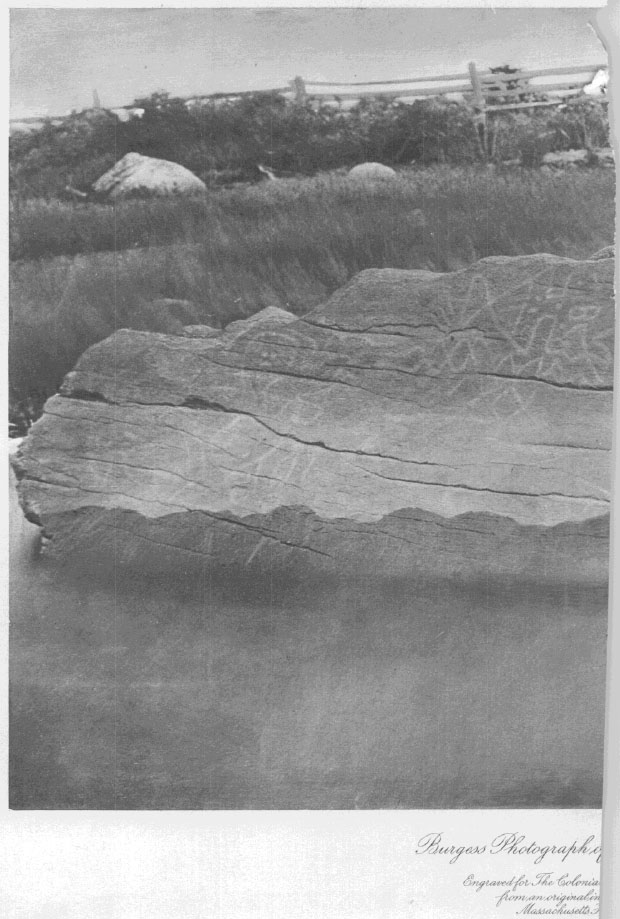
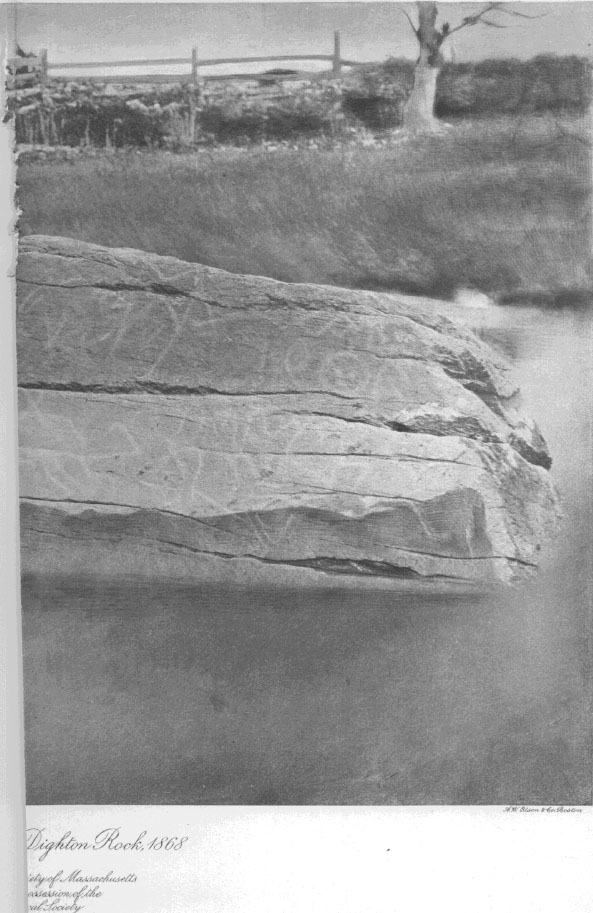
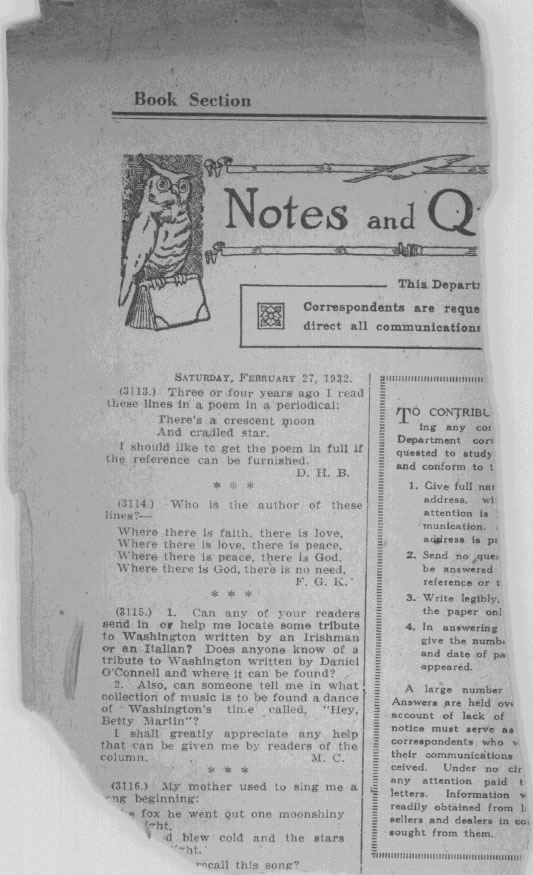
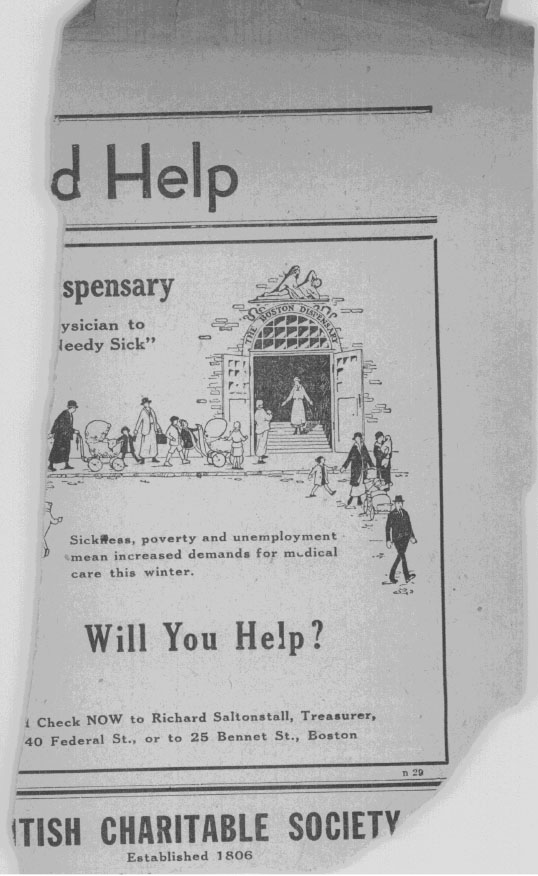
Mr. Albert Matthews communicated the following paper, written by Professor Edmund Burke Delabarre of Brown University:
EARLY INTEREST IN DIGHTON ROCK
Among the other curiosities of New England, one is that of a rock, on a perpendicular side whereof, by a river which at high tide covers part of it, there are engraved, no man alive knows how or when, lines filled with strange characters; which would suggest as odd thoughts about them that were here before us, as there are odd shapes in that elaborate monument. Probably no one now alive, uninfluenced by the quaint phraseology of the past, would choose exactly these words in which to describe the Dighton Writing Rock and our knowledge of it. Yet the statement is true to-day, though far from a complete statement of our knowledge. Its particular interest is that, being still though incompletely true, it is, with two unimportant omissions, the first known published description of the so-called Dighton Rock.
This does not imply that we know no more about the rock than was known in Cotton Mather’s time. On the contrary, archaeological opinion is agreed as to its general nature and origin.353 Yet it still remains true that as to detail, no man knows just how or when the lines were cut, or what they mean; and that they still suggest odd speculations, as they did two hundred years ago and have been doing abundantly in all the intervening years.
No single object of antiquarian interest in America has been so much discussed, probably, as Dighton Rock. Interest in it is still keen, as is evidenced by the fact that no year goes by without some published reference to it. Just how important it has been considered is impressively shown by examination of a chronological bibliography listing not only papers specifically on this subject alone, but also references to it in papers or books on other subjects, and other known evidences of interest in it. In compiling such a bibliography I have found thus far 52 items belonging to 26 years out of the 120 between 1680 and 1799; 32 items in 18 years of the 37 between 1800 and 1836; 148 items in 35 years of the next 35, to 1871; and 197 items in 43 years of the 45 since 1871, — more than 400 items in all. It is probable that further search will largely increase this list, and fill in many of the few missing years. Some of the items, of course, are trivial; but many of them are due to authorities of the highest eminence in their time. Particularly during the period when the “Phœnician Theory” of the origin of the rock was under discussion, about 1800, and again after the “Norse Theory” had been announced, in 1837, no one of repute in such matters in this or foreign countries failed to give expression to his opinion. Nearly twenty first-hand copies of the inscription, many of them exceedingly different from the others, exist in printed form, and fully as many more have been made but never published; and some twenty different theories have been advanced to account for its origin.
In view of all this interest and discussion, it is a little surprising to realize that the whole history of the subject needs to be re-written. No one has yet assembled all the copies of the inscription, or shown what is actually “engraved” on the rock. The only photograph known to me which shows at all clearly how the rock appears to an actual observer, without emphasis or interpretation of any of its features, is given as a frontispiece to this paper, and has never been published.354 It is interesting to note that in this photograph careful scrutiny, aided by an active imagination, can easily discover and correlate all the varying copies that have been made. What the unknown inscribers actually intended beyond what this photograph reveals, is now and may always remain a matter of speculation alone. But those who have made varying copies have not thought that they were indulging in speculation. It seems to have been characteristic of each that he believed that he drew only what he was. sure was there, or what his companions all agreed on; and represented sometimes by dotted or by fainter lines whatever he thought was doubtful. Nevertheless they disagree radically. It follows that we have here an exceedingly interesting problem in the psychology of perception, as well as another in the psychology and art of copying. Moreover, however the figures were depicted, there has been an astonishing variety of interpretations as to what they mean. They present, therefore, another attractive problem concerning scientific methods of reliable interpretation, and psychological reasons for both right and wrong interpretations. Into these matters it is not the purpose of this paper to enter. It remains further true, however, that no one has yet brought together all the available historical facts concerning the rock and discussions of it; and not only have important omissions been made in this regard, but a considerable number of early occurring errors have been perpetuated without correction. The whole subject, then, needs to be surveyed anew, and to receive its first fully comprehensive presentation. The fulfilment of this task would require much more space than the present occasion affords. Enough neglected material and uncorrected error exist to justify giving separate consideration to the earliest studies and facts that have a bearing on the history of Dighton Rock, ending with the year 1730.
The name itself by which the rock is commonly known is a partial misrepresentation. Once or twice only in all its history it has been correctly called the Assonet Rock, or Monumentum Assonetense. For fifty years after the settlement of neighboring parts, the land on which it stands remained in the possession of the Indians. Since then, the shifting lines of townships have made it successively a part of Taunton, of Dighton, and of Berkley. Through all these changes, however, the name Assonet Neck persisted, and it is on Assonet Neck that the rock is situated, just across the Taunton River from the present village of Dighton.
Uncertainty as to Date of the Inscription
It must have been very soon after the settlement at “Cohannet alias Taunton,” in 1637, that the rock was first seen by white men. But whether it then had artificial markings on its surface we do not know. There is only one fact, and that not a conclusive one, that could be regarded as evidence that it had. This is the unquestionable faintness and uncertainty of the marks at nearly the earliest dates at which we have knowledge of it. How clear it appeared to Danforth in 1680 we do not know. If the lower part of Mather’s 1712 version was genuinely copied from the rock, the exceeding badness of the copy cannot be explained by unskilled draughtsmanship alone, and must indicate that the inscription was then practically as faint as it is to-day. But this part of Mather’s drawing cannot be relied on as actually derived from the rock. In 1730, however, Greenwood found the indentures “not very considerable,” and had difficulty in determining what were real indentures. His whole description, given in full later in this paper, makes the inference almost unavoidable that the wear and tear of the last two hundred years have scarcely at all increased the difficulty of deciphering the characters, except perhaps on the lowest part of the face. It would seem, then, that we must conclude either that the inscription is very ancient, as has so often been believed, or that its makers cut the lines so thinly that only slight weathering was needed to render most of them obscure. More than one authority on Indian petroglyphs describes cuttings that were exceedingly shallow.355 The dimness of the artificial lines, noted in the earliest detailed description of the rock that we possess, cannot therefore be regarded as a decisive indication of great antiquity.356 And there is no other indication of it than this. It follows that we do not know when the work was done. It is even possible, so far as real evidence shows, that it was at some time, or at various times, within the fifty years after the whites had settled in the neighborhood, during which the Indians still retained possession of Assonet Neck.357
Two statements have been made which, if true, would tend to invalidate this conclusion. One is, that “the Indians were ignorant of the existence” of such inscribed rocks;358 or that “the natives could not render any account of its origin, when the Europeans discovered the country.”359 The other claims that “the rock was seen and talked of by the first settlers in New England,”360 or “found there on the arrival of the first New England colonists.”361 No statement of either sort appears in the literature of the subject previous to the earliest one here noted. The second of the two seems to exhibit mere ignorance of the facts, since the first discoverable notice taken of the rock was in 1680, and the first printed reference to it in 1690. The other, I suspect, has always been founded solely on Greenwood’s misleading citation of Danforth’s tradition about the “wooden house.”362 As I read it, this was given by Danforth simply as an interesting incident connected with the river, which he had just named, and not necessarily as having anything to do with the rock. It was Greenwood who, fifty years later, without warrant from Danforth’s language, assumed that it was narrated with relation to the rock, and drew from it the unjustified conclusion that “this monument was esteemed by the oldest Indians not only very antique, but a work of a different nature from any of theirs.” Examination of Danforth’s own words is all that is needed to show how slim a basis they afford for the statements that we are discussing. Even if taken as having reference to the rock, there were doubtless other and conflicting traditions of equal value, of which Danforth, a casual visitor to Taunton, did not happen to learn. Benjamin Jones, a resident of the locality and owner of the rock, appears to have related one such to Greenwood and to Dean Berkeley in 1730,363 and Kendall gathered a number of them in 1807. Jones’s tradition may fairly be balanced against Danforth’s; and against Greenwood’s belief as to what is proved, may be set the contemporary opinion, apparently accepted by Berkeley, that the Indians were the responsible parties. Besides which, we may reasonably doubt that Danforth’s story was meant to imply anything whatever as to the occasion of the inscription.
Plate II
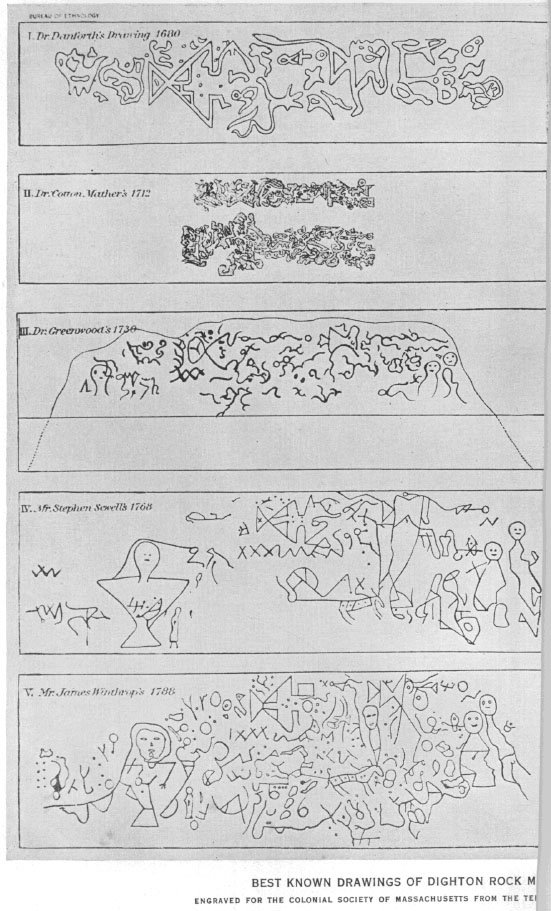
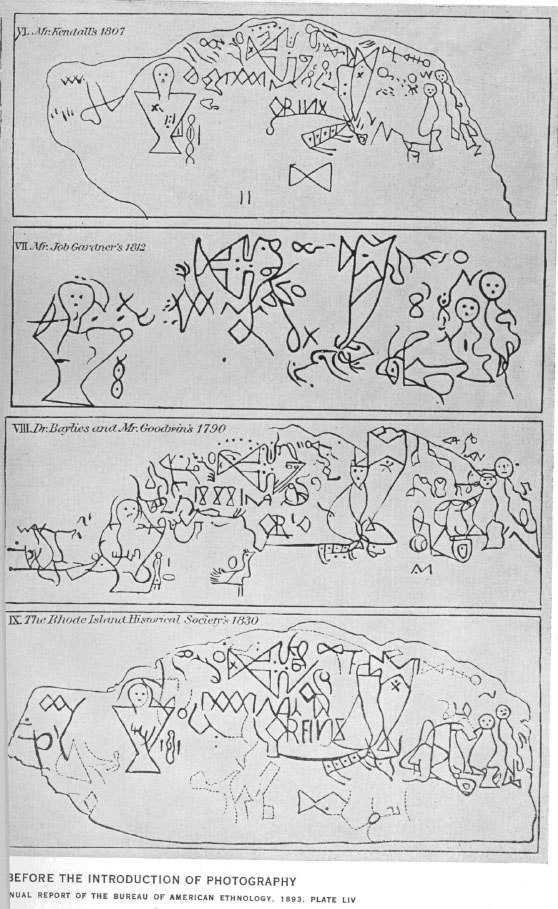
There remains one further bit of apparent evidence that the inscription was surely made before the arrival of the colonists. It is suggested by L. N. Kinnicutt364 that the name Assonet is derived from hassun-et, “near the rock,” and that Dighton Rock is implied. If so, since the name was in use as early as 1640, the rock was a prominent landmark to the Indians before that time. But there are rival derivations of the name, so that the meaning assigned by Kinnicutt is by no means certain, and cannot be taken as genuine evidence.365 We may finally conclude, therefore, I think, that we are not warranted in assigning to the inscription any definite date, whether before or after the earliest days of the Colony.
Knowledge of the Rock by the Colonists before 1680
That the inhabitants of Taunton, however, must have seen this rock, already inscribed or not, very soon after their arrival is perfectly clear. One of the most prized natural products of the region was the fine hay that still grows abundantly on the tide-washed flats bordering on the Taunton and the Assonet Rivers. There are such salt marshes or meadows still in use on Assonet Neck, both above and below Dighton Rock and not far from it; a small one in a Cove at the rock itself; and one on Grassy Island, which lies in Taunton River hardly more than a stone’s throw from the rock. Within three years after the first settlement there, these meadows were assigned to the proprietors of Taunton: “Whereas the inhabitants of Cohannett, now called Taunton, haue complayned of thire greate want of meddow grounds . . . the Court doth therefore now order and graunt the meddow lands at Assonet . . . vnto the said inhabitants of Taunton.”366
From another order of the General Court of Plymouth, dated June 6, 1643,367 it appears that Assonet Neck, already bearing that name, was known to and desired by the men of Taunton. After acquiring its meadows, they soon proceeded to assign them to certain individuals among them. Unfortunately the record of the earliest grants is lost. The first reference368 we can now find to the meadows at Smith’s Cove, a little above Dighton Rock, apparently occurs in a record of 1669, and in one of 1680 the first to “Henry Hodges meadow,”369 just below the rock. But we do know that the meadow at Grassy Island, close by Dighton Rock, was assigned to the Rev. William Hook in accordance with a Court Order of 1640 that “competent meddow & vplands” be “layd forth” to him and others;370 for in 1644, when Mr. Hook sold his holdings, he expressly reserved to himself two parcels of meadow, “the one lying at Grassy Island, the other at a place called Assonet.”371 Moreover, there are still preserved in the Proprietors’ Records of Taunton at least two records of grants of meadows on Assonet Neck or near-by, farther away than the meadows near Dighton Rock, in 1648; and numerous others in 1657 and immediately succeeding years.372 We may then safely conclude that hay was cut from all the near-by meadows almost from the beginning and that all the prominent rocks on the shore must have fallen within the range of vision of the white men; even further, that in their search for hay they must have inspected the little cove373 at Dighton Rock itself. Dighton Rock, therefore, had been seen by whites, probably as early as 1640. But this fact does not warrant any conclusion as to whether it was then inscribed or not; for no one seems to have thought to make an enduring statement as to its existence or appearance.
Plate III
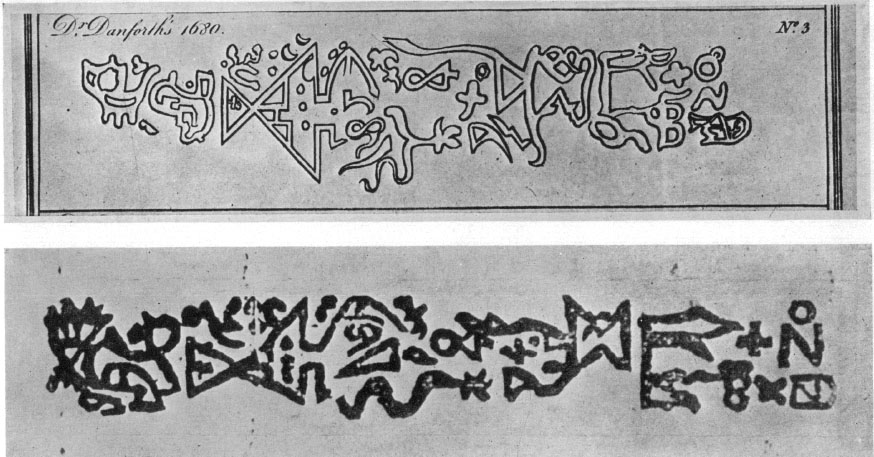
LORT’S REPRODUCTION OF DANFORTH’S DRAWING, 1680
FROM ARCHAEOLOGIA. 1787. VIII. PLATE XVIII
COTTON MATHER’S DRAWING, 1690
FROM MATHER’S WONDERFUL WORKS OF GOD COMMEMORATED. 1690. ENGRAVED FOR THE COLONIAL SOCIETY OF MASSACHUSETTS
Assonet Neck and the Indians
There is another question of importance concerning this earliest period, of whose solution we know little. How much use did the Indians actually make of Assonet Neck? Was it in any way regarded by them as especially important or precious? It is often assumed that it was one of their most prized possessions. “No offers that the English had made,” says Ebenezer W. Peirce,374 “were found sufficient to induce the Indians to part with their loved resort upon Assonet Neck.” “Assonet Neck was peculiarly the camping ground of the Wampanoag Indians. They retained possession of it longer than of any of the surrounding country, on account of the convenience of the oyster, clam and other fisheries.”375 The earliest discoverable statement of the sort is that of Isaac Greenwood in 1730, given in full on a later page of this paper, that “this Place was One of ye most considerable Seats of Indians in this Part of ye World, and the River remarkable for all Sorts of Fowl and Fish.”376 The one clear fact is that the Indians never did sell Assonet Neck, though efforts were made to buy it. This might conceivably have been because of the relative remoteness of the place, or for other reasons, rather than because of any particular love for it or extensive use made of it. Contemporary records are silent as to this. We only know that they did not sell, not why this was so. Examination of the Neck itself has not yet discovered any considerable signs of Indian occupancy. The so-called “Indian corn-hills,” it is true, are still very numerous and in splendid preservation. Indian relics are found on the Neck, but not more abundantly than elsewhere. Much more extensive shell-heaps exist in Freetown, whose lands the Indians sold in 1659, than are known on Assonet Neck. The place was inhabited by Indians, without question. But there is nothing yet, in records or in material remains, to show that it was held in exceptionally high esteem. It may well have been that it was; but evidence is lacking.
The few records that have a bearing on this matter, though inconclusive, are interesting. When Winslow and Hopkins, on their first visit to Massasoit in July, 1621, had crossed the river at the “knowne shole place” in Taunton, they went on down the river on the side opposite from Assonet Neck. “As we passed along, we observed that there were few places by the River, but had beene inhabited, by reason whereof, much ground was cleare, saue of weedes, which grewe higher then our heads.”377 The recent plague, however, had entirely depopulated this part of the country.378 It is probable that the salt meadows along Taunton River were included in the original Cohannet purchase, for they were soon made use of by the settlers, as already noted. Moreover they are expressly mentioned in Philip’s confirmatory deed of 1663. But some of them were sold again by the Indians to other parties in the “Freemen’s Purchase” of 1659; and this fact gave rise to protracted disputes between the proprietors of Taunton and the “ancient ffreemen.” The published histories of Taunton and of Freetown say nothing as to the settlement of these disputes; though how they all ended happily can be discovered from a probably unpublished document, which we shall have cause to mention again shortly. In 1643, apparently, an unsuccessful attempt was made to purchase Assonet Neck: “Whereas they [the inhabitants of Taunton] desire the Neck of Assonett for pastureing yeong beasts, it is also graunted by the Court, ꝑuided leave can be ꝑcured from Vssamequin, and all payments to be made by themselues, without any Charḡ to the countrey.”379
There is widely current a tradition that Assonet Neck was “a place of banishment among the Indians.” It is first mentioned in 1807 by an English traveler, Edward A. Kendall.380 It is commonly assumed in the neighborhood that this fact of “banishment,” as well as the name “Conspiracy” attached to a small island at the lower end of Assonet Neck, had something to do with King Philip’s War. But this assumption is disproved by a record of 1670, — the record above referred to of the final agreement between the proprietors of Taunton and the “ancient ffreemen” concerning the position of the line between their possessions and the ownership of certain meadows about Assonet Bay and along Taunton River.381 A part of their agreement reads thus: “All the Marsh or Meadow land at Assonate on both sides of Assonate Bay but not to extend any part to ye place commonly called the Banished Indians . . . shall be and is concluded to be Taunton meadows.” The description is not definite enough to enable us to say whether this place was on the Neck itself. If not, it must have been in its close vicinity. We have no knowledge as to the reason for the name, nor for that of Conspiracy Island.382
A record of 1673, testifying that a certain tract of land, bounded in part by Assonet and Taunton Rivers, is the property of an Indian named Piowant, clearly refers to Assonet Neck. In this record383 there occur two Indian local names that we might well wish had been preserved, instead of their probable modern equivalents of Stacy’s Creek and Smith’s Cove — “a smale Riuer or brooke called by the Indians Mastucksett,” and “a place in Taunton Riuer called and knowne by the Name of Chippaseutt.”384 The document was signed by the squaw-sachem Wetamo and five other Indians. If Piowant alone was regarded as owner of the Neck — not Philip, nor other Indians of rank and prominence — does this fact have any bearing on the probable extent to which the place was occupied and used?
Plate IV
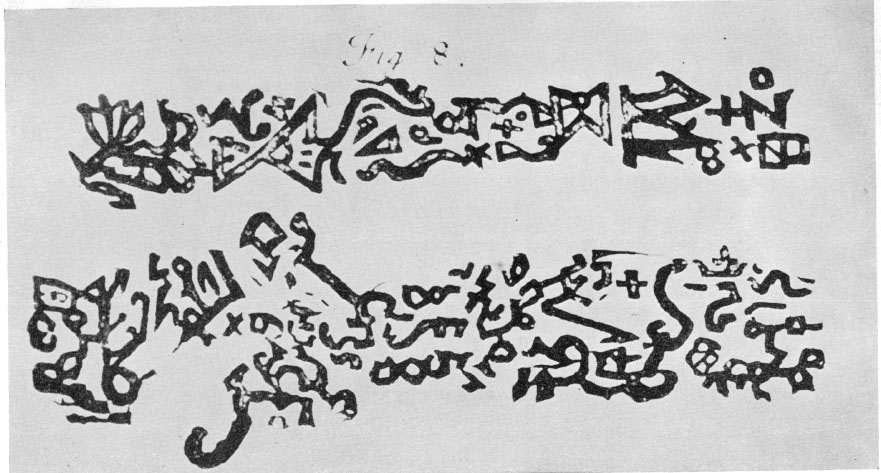
COTTON MATHER’S DRAWING, 1712
ENGRAVED FOR THE COLONIAL SOCIETY OF MASSACHUSETTS FROM PHILOSOPHICAL TRANSACTIONS. 1714. XXIX, NO. 339
In 1676 the lands of Assonet Neck and some other places were seized by the Colony of New Plymouth as “conquered lands,” and ordered to be sold to defray the debts occasioned by King Philip’s War.385 The sale of Assonet Neck to six men of Taunton for the sum of one hundred and fifty pounds was effected on November 12, 1677. The sale is on record,386 and the original deed itself was discovered in 1875 among papers of the Walker family by Ebenezer W. Peirce387 and is now in possession of the Old Colony Historical Society of Taunton.388
Though there are other references to Assonet Neck during the period thus surveyed, yet these are all that I have yet discovered bearing in any way on the question of the Indians’ relation to it. Actual facts are few, and are as non-committal as are those concerning knowledge of Dighton Rock by the early white settlers. Their assemblage is at least of value in showing that opinion in favor of a great antiquity for the inscription, and against the possibility of its having been made by the Indians, must be matter of speculation only; and that the positive statements that have been ventured on these questions are unwarranted. Perhaps it may not be unreasonable to hope that further pertinent facts are known to some, and may, in consequence of this display of ignorance after diligent search, be brought to the writer’s attention.
Identity of “Rev. Dr.” Danforth
An age of myth passes into one of historical accuracy by slow stages. In the intermediate period grains of truth appear, but long remain mingled with inaccuracies of statement and inferences undistinguished from fact. Eventually these unreliable features may get sifted out, and possibly new truths may come to light. In the case before us, several errors and inferences first made have thus far persisted without correction, in spite of two hundred years of vigorous discussion; and there are new facts to record. The first printed reference to Dighton Rock — in fact, the earliest first-hand record of any kind of which we can be sure — was made in 1690. But ten years earlier, in 1680, a semi-mythical personage emerges, the “Rev. Dr. Danforth.” In all the literature of the subject there is no decisive indication as to who this person was. Fortunately, however, it is possible now to establish his identity beyond question, and thus to begin the historical period of Dighton Rock definitely with the year 1680.
This “Danforth,” we are told, made a drawing of a portion of the inscription in 1680; narrated a legend concerning it; and ventured a statement as to what two of its figures signified. We are indebted to the researches of the Rev. Michael Lort, in 1786, among the unpublished records of the Royal Society and of the Society of Antiquaries of London, for the first mention of these facts and the first publication of the drawing — over a hundred years after the observations were made. Lort’s information came, as he says, from an entry in the Minutes of the Society of Antiquaries of London, which quoted a letter written by Professor Greenwood in 1730. The letter from which the Antiquaries’ extract was made was found recently in the British Museum by David I. Bushnell, who published a transcript of it, not wholly reliable, in 1908.389 This adds no further information concerning Danforth to what Lort had already told. It does, however, give a photographic reproduction of Danforth’s drawing, which conveys a very different impression from that given by Lort’s presentation of it. Another small item completes all that we have ever been told about Danforth and his opinions. James Phinney Baxter, writing in 1887,390 referring to a letter to which he assigns an erroneous date, and which he wrongly says was addressed to Sir Hans Sloane, quotes certain words practically identical with those attributed to Danforth in Lort’s and in Bushnell’s Greenwood letter, though without mentioning either who wrote the letter, or that the quoted words were Danforth’s. He gives, however, a sentence not found in Lort, which has really served as the clue to our later discovery of the real Danforth. “In another place,” Mr. Baxter says, “he adds to the account, that ‘they slew yr Saunchim.’” This sentence is certainly not in the Greenwood letter from which Lort derived his information, and hence points to another source of information. In a paper on “Early Voyages to America” two years later Mr. Baxter repeats this quotation, again misstating the date and the recipient of the letter, again also omitting to mention the name of its writer and the fact that Danforth was author of the portion quoted, and adding the further error that the letter is in the Sloane Manuscripts in the British Museum.391
Plate V
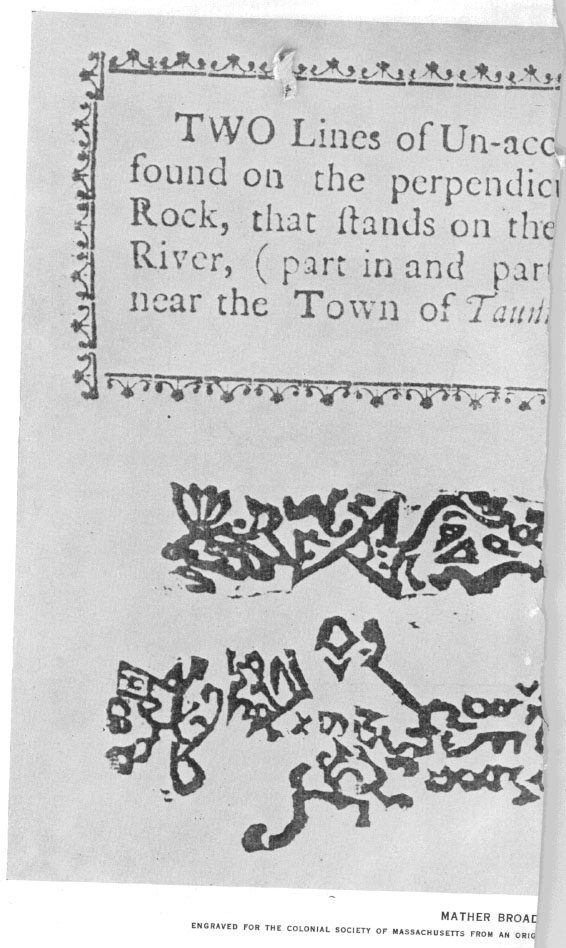
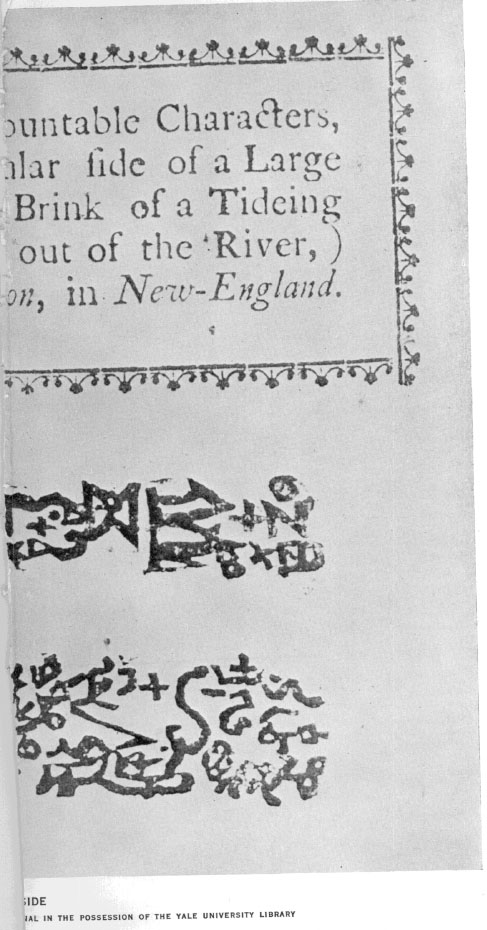
All that Greenwood said concerning Danforth, in the letter quoted by Lort and transcribed by Bushnell, after mentioning the fact that he sends a “Draught of some parts of this Inscription taken by the Revd Mr. Danforth 1680,” is this: “This Gentleman observes with relation to it, that there was a Tradition current among the eldest Indians ‘That there came a wooden house (and men of another Country in it) swimming up the River of Assoonet (as this was then called) who fought the Indians with mighty Success &c.’ . . . Some take this Inscription to be Hieroglyphical, thinking that in N° 2 the first figure represents a Ship without Masts and a mere Wreck cast upon the Shoals. The second representing an Head of Land possibly a Cape with a Peninsula Hence a Gulf (this according to Mr Danforth).” Under the drawing by Danforth, Greenwood writes: “No 2 Delineata per Dom Danforth Anno 1680.”392 Add to these statements Baxter’s discovery that “they slew yr Saurichim” (or “Saunchem,” as he also spells it), and the further fact that Lort spoke of our hero as the “Rev. Dr. Danforth,” thus setting a fashion which has been followed by practically every one else since then, and we have the sum total of information concerning Danforth and his drawing and opinions which has yet been made public.
Who was this “Rev. Dr. Danforth”? It is generally and naturally assumed that it was the Rev. Samuel Danforth of Taunton. This assumption, however, presented one difficulty to any one who looked carefully into the facts. Samuel was son of the Rev. Samuel Danforth of Roxbury (who died in 1674) and was born December 18, 1666. In 1680, therefore, he was only thirteen years old, was a Freshman or Sophomore at Harvard, and had very likely never been in Taunton. He graduated in 1683, remained at College as Resident Bachelor, and took his A.M. in 1686. Shortly afterward he was called to the church at Taunton, and was ordained there September 21, 1687 — seven years after the drawing is reported to have been made. On the other hand, there seems to have been only one other Danforth in 1680 who afterward became a clergyman. Neither of them held the title “Doctor.” This other Danforth was Samuel’s brother John, born November 9, 1660, graduated from Harvard College 1677, either a Resident Bachelor at Harvard in 1680 or just leaving there with the A.M. degree, and nearly twenty years old. He was afterward minister at Dorchester.393 There is nothing in all the published facts concerning John Danforth to suggest any interest on his part in Dighton Rock. Under these circumstances it was not unnatural to suppose that Greenwood referred to some other Danforth, who was not a “Rev.” (neither of these two was such in 1680), or that the 1680 was an error, perhaps for 1688 or 1689. If the latter, then nothing would have been more natural than to suppose that the Rev. Samuel, soon after his coming to Taunton, heard of the curious inscribed rock, which was then within the limits of his parish,394 and soon went to see it and was interested enough to make a drawing of a portion of it. It is known that he was later greatly interested in the Indians and their affairs and compiled an Indian Vocabulary.395 Until very recently, therefore, the conclusion seemed practically certain that it was the Rev. Samuel Danforth who was referred to, and that the drawing was made in 1688 or even later.396
Acting on the clue furnished by Mr. Baxter, however, I have had search made in the British Museum for additional material, and have obtained from the Assistant Secretary of the Society of Antiquaries of London a transcript of the entry in the Minutes of that Society from which Lort drew his information. Both quests have yielded important results. Through the one, we can positively identify the Danforth concerned, as well as verify and add detail to the date. Through the other, we now know why he has always been dignified with the unmerited title of “Dr.”
John Danforth’s Drawing, 1680
It was the Rev. John Danforth, later of Dorchester, who made the drawing, and it was in October, 1680, that it was done. This we learn from a statement in a second letter by Greenwood, now in the British Museum.397 This is doubtless the letter from which Baxter quoted; and it was also seen there by Bushnell, but not transcribed.398 Possibly neither of them read the portion containing this new information. Certainly neither of them realized its importance sufficiently to quote it. There is practically nothing else concerning Danforth in this second letter additional to what is contained in the first,399 except that it also contains a version of Danforth’s drawing differing slightly from the other. Both of these drawings are reproduced in our plates; and we also present for further comparison a reproduction of Lort’s rendering of Danforth.400 It will be noted that the two drawings, as sent by Greenwood, have the figures solidly blocked in, while Lort’s version is in outline only. It is this fact mainly which has made the Danforth drawing appear at first sight so different in character from all subsequent ones. The drawings will receive more detailed study in our later discussion of Greenwood.
As to the value of Danforth’s drawing, beyond its historical interest, comparison with all the other available depictions that we have of this part of the rock convinces me that this is at least as faithful and accurate as any, and it has the additional advantage of being earlier by fifty years than any other and of showing some portions of the rock that have apparently since then broken away. I am inclined to speak even more positively. The most truthful of all depictions are of course those that leave the greater part of the figures vague and uncertain, as they really are. Of these, the Burgess photograph of 1868, here reproduced for the first time, is the best. The only other examples are the Kendall painting of 1807, badly misrepresented in all its reproductions except the one by Kendall himself in an engraving in the third volume of the Memoirs of the American Academy of Arts and Sciences in 1809; and the unpublished Seager drawings of 1864, in the collection of the American Antiquarian Society. But I think it very probable that the Danforth of 1680 is the best of all that have attempted to interpret the characters into perfect clearness. Other critics have not always agreed with this opinion, some of them having, in the theories they were advocating, personal reasons for prejudice. Such other opinions as I have happened to transcribe into my notes I give as examples in a footnote.401
Plate VI
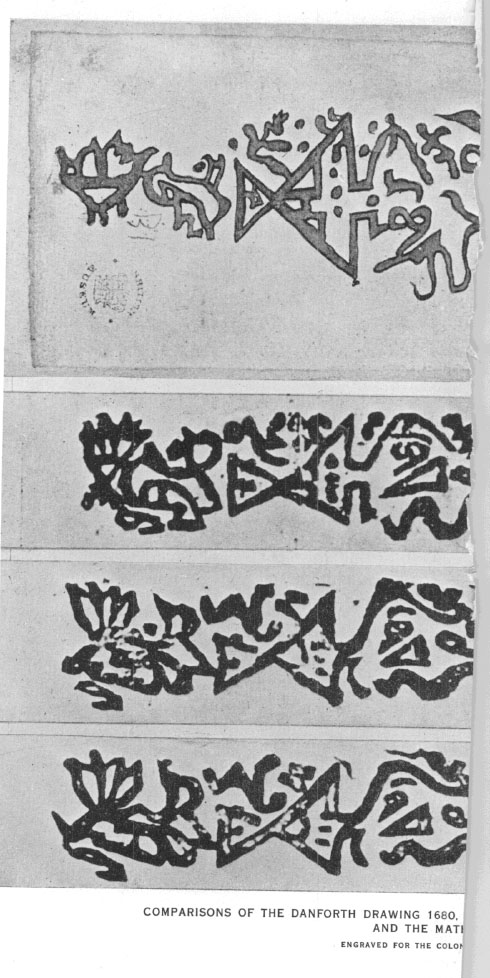
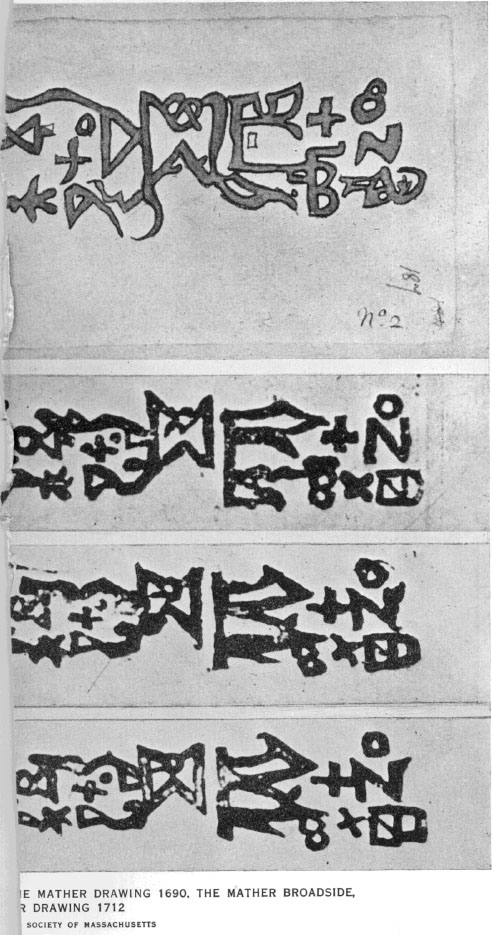
It will be remembered that under the drawings accompanying the first Greenwood Letter (called Letter A in our later discussion), Greenwood wrote: “Dom Greenwood,” “Dom Danforth.” The “Dom” evidently signifies merely Dominus, “Mister.”402 But it is easy to see that this could very readily be mistaken for “Dr.” And this is what actually occurred. The Assistant Secretary of the Society of Antiquaries informs me that in the Minutes of the Society the drawings were reproduced, as well as a portion of the letter; and that under them is written: “Dr. Greenwood,” “Dr. Danforth.” The error, therefore, was not Lort’s in 1787, but was made when the record was entered in these Minutes, in 1732. This, then, is the reason why both of these men, to neither of whom the title belonged, have been “doctored” in all the literature of Dighton Rock which makes any mention of them, except to call them just plain “Danforth” or “Greenwood” only.
It was not until more than a hundred years had passed after John Danforth made his drawing, as has been said already, that any mention of it was published. What was then made known through Lort403 became matter of common knowledge in the period of excited discussion following the publication of Rafn’s elaborate work404 in 1837, with its promulgation of the startling theory that the inscription on Dighton Rock was due to adventurous Northmen in the year 1008. Our chosen limitations prevent us from entering into any discussion of that as well as of many other interesting theories. We may be pardoned, however, for dwelling on the strangeness of the fact that, with the information available, as we shall see it was, to Lort, and so nearly found by at least two observers since, it is only now, a good deal more than another hundred years since Lort, that Danforth’s real identity comes to light.
Cotton Mather’s Description and Drawing, 1690
The first printed reference to Dighton Rock was made by Cotton Mather in 1690. It has been mentioned in very few even of the most complete discussions of the subject. Lort does not speak of it, nor does Rafn in what he attempted to make an exhaustive survey of previous discussions and a complete collection of all previous drawings. Consequently, although a very large number of writers enumerate the copies of the inscription, there are only two or three of them who include this item.405
Mather delivered a sermon on December 19, 1689, which he published in 1690 under the title The Wonderful Works of God Commemorated.406 Before the sermon, the book contains an Epistle Dedicatory “To the Right Worshipful Sir Henry Ashurst, Baronet.” Near the end of this Epistle occurs the following account of Dighton Rock:
Among the other Curiosities of New-England, One is that of a mighty Rock, on a perpendicular side whereof by a River, which at High Tide covers part of it, there are very deeply Engraved, no man alive knows How or When, about half a score Lines, near Ten Foot Long, and a foot and half broad, filled with strange Characters; which would suggest as odd Thoughts about them that were here before us, as there are odd Shapes in that Elaborate Monument; whereof you shall see, the first Line Transcribed here.
This is followed by a crude cut of the supposed “first line,” which we reproduce in Plate III, from a photostatic copy. The dimensions of the original are about one half inch by three inches.
Mather changed his opinion later, as we shall see, as to the number of lines; and was mistaken in thinking that the inscription was arranged in “lines” at all. He probably never saw the rock himself, and nowhere claims that he did. He certainly did not himself originate either this drawing or the one that he sent to the Royal Society later. Whence, then, did he obtain the drawing? Unfortunately his Diary gives no clue, for the portions from January 8, 1687, to May 17, 1690, are missing, and it is doubtful if they would have made mention of such a matter anyway. Nor does there seem to be extant any statement elsewhere, by him or by others, that gives the information. Yet we can be almost absolutely certain as to its source.
One of our plates407 shows the nine most commonly reproduced representations of the Dighton Rock inscription. These nine were first gathered together by Rafn, and have been shown in this tabular form by Winsor408 and by Garrick Mallery.409 Among the nine copies exhibited, one is that of Cotton Mather 1712, the upper part of which, representing the same “first line” as this 1690 cut, is almost identical with the latter. A glance at this 1712 Mather, the only one ever heretofore reproduced, gives the impression that it is utterly dissimilar to any of those by other artists. The impression is due, however, almost wholly to the small size of the cut and to the fact that its lines are broader and blacker than in other representations. Lort’s reproduction of Danforth also looks different from the other drawings, as well as from the Mather, largely because it too represents the lines broad, and in outline only. Naturally no one has suspected a relation between the two. When I first saw the Bushnell photograph of Danforth as actually sent by Greenwood, with the lines not in outline but fully filled in, it occurred to me that it was not so dissimilar to the others as I had supposed. It then further occurred to me to enlarge the 1690 Mather to the same size as Bushnell’s Danforth, and to compare the two. The result is to show a very remarkable degree of similarity. To compare Lort’s Danforth with the enlarged Mather does not bring out the similarity very well. Consequently, to facilitate this comparison and another that is to be made later, I have brought together onto one plate one of the two Greenwood versions of Danforth, photographically reproduced, drawn in full lines instead of outline; the 1690 Mather enlarged to the same scale; and two other versions by Mather of a later date.410 The Danforth and Mather are unquestionably different. At first sight one might think that no one could have copied one from the other and have done it so poorly. But this consideration loses its force on comparing the 1712 with the 1690 Mather, and again with what we later call the “Broadside” Mather, which are also given in our plate together. The three Mather versions differ from one another almost, if not quite, as markedly as the 1690 Mather does from the Danforth. The evident truth is that Mather was not a careful and accurate copyist. He was content to convey a general impression, and allowed himself almost unbelievable liberties in the details of his copying. It was doubtless not peculiarly a fault of Mather alone to be thus careless of accuracy. Although exhibited by him in an extreme degree, yet it was more or less characteristic of his time, as was so sensibly observed by Professor Kittredge411 concerning his alleged credulity; and it is a feature which has not disappeared entirely from scientific work even yet. When the Philosophical Transactions were abridged by Jones in 1721, he reproduced Mather’s original cut of 1714, but with some differences. Mallery’s presentation of the same cut is again somewhat different. If we count the “Broadside” as a Mather, we have then at least five versions of the “first line” of Mather, each exhibiting differences from the others.412 Were it not for the photostat, our own exactitude of reproduction would have been impossible. Where there was no need for scientific accuracy and no intention of attempting it, as in Mather’s case, considerable differences in copies were inevitable.
If now, with these considerations in mind, we again compare Mather with Danforth, and the two with all the rest, we must be convinced that they are of the same type, that they present a clear family resemblance. No drawing or photograph made by any one else in all the history of Dighton Rock shows this kind of resemblance. As an expert can identify differing samples of an individual’s handwriting, so here careful study and comparison show the kind of quality in these two drawings which makes it almost if not fully certain that they come from the same original source. Mather was intimately acquainted with Danforth. They both show the “first line” only. Mather speaks of it very soon after Danforth becomes settled as a minister in a place near Boston.413 The conclusion is unavoidable that Mather copied his drawing from Danforth’s. Danforth’s, then, is the only original drawing of this part of Dighton Rock that we know of until Greenwood made the second known copy of the inscription direct from the rock in 1730.
Plate VII
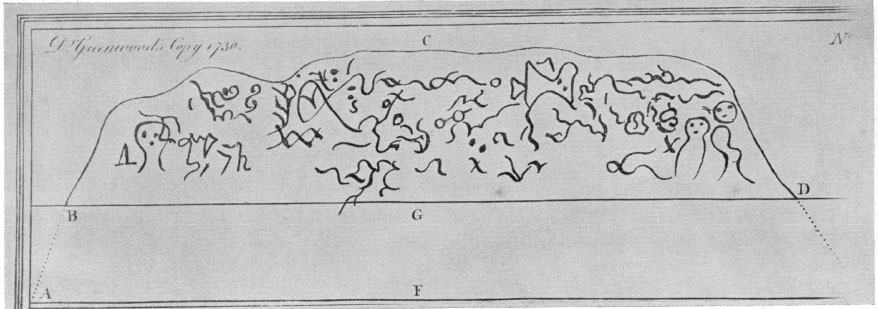
LORT’S REPRODUCTION OF GREENWOODS DRAWING, 1730
ENGRAVED FOR THE COLONIAL SOCIETY OF MASSACHUSETTS FROM ARCHAEOLOGIA, 1787, VIII, PLATE XVIII
Samuel Sewall’s Reference to the Rock, 1691
The next discoverable reference to Dighton Rock appears in the Letter-Book of Samuel Sewall in 1691. As this has been put in print only recently, it is natural that no previous writer on the Rock has discovered this case of its receiving mention. The entry reads as follows: “Febr. 24, 1690/1. Memorand. to write to Mr. Danforth to take the writing off the Rock and send it.”414 The editors of the work have inserted a footnote reading: “Probably at Dighton.” The index to Series 6 of the Massachusetts Historical Collections refers to this passage, though for what reason it is not easy to see, under the name: “Rev. John Danforth, of Dorchester.” We have no further knowledge of the reason for Sewall’s desire, or as to which Danforth he intended to write to, or as to whether he carried out his intention. It may be that he sought for evidence in support of the theory that the American Indians were descendants of the ten lost tribes of Israel. In 1650 Thomas Thorowgood415 had advocated this view, as had many others. Samuel F. Haven tells us: “The Mathers, Samuel Sewall, and most of the prominent scholars and theologians of Massachusetts, were inclined to the same opinion, which has never failed to find supporters.”416 Sewall’s Letter-Book417 shows traces of adherence to this view, though nowhere advocating it without reserve. Greenwood’s letters, given below, show that some theory of Oriental origin for Dighton Rock was in the minds of scholars in 1730; and President Stiles,418 Colonel Valiancy,419 Samuel Harris,420 and others, actively advocated such theories in 1783 and later. We do not know that Mather or Sewall ever thought of Dighton Rock in this connection; but in view of the above cited facts, this theory might well have contributed to Sewall’s interest in the Rock.
Cotton Mather’s Drawing, 1712
The next contribution to the subject was made again by Cotton Mather. We can most briefly present the circumstances in the words of Professor Kittredge, as given on the first page of his paper cited above. “In November, 1712, Cotton Mather composed a series of thirteen letters on the Natural History of New England and kindred topics. Seven of them were addressed to John Woodward, M.D., F.R.S., Professor of Physic at Gresham College, and six to Richard Waller, Esq., Secretary of the Royal Society. All were intended as communications to that learned body. Excerpts from these letters were printed in 1714 in No. 339 of the Philosophical Transactions, — the number designated as ‘for the Months of April, May and June.’”421
Among the curiosities of which Mather made mention in these letters, Dighton Rock was included. I am indebted to Professor Kittredge for a transcript of Mather’s original words on this subject:
At or Taunton by the side of a Tiding River, part in, part out, of the River, there stands a large Rock; on the perpendicular side of which Rock next the River, there are seven or eight Lines, seven or eight foot long, and about a foot wide, each of them in unaccountable characters. It is generally taken for granted, that they are Artificial; and there they stand Graven in the Rock forever; but no man as yett has been a Zaphnath Poaneah enough to know any more what to make of them, than who it was that graved them. I have not yett been able to gett all ye Lines; which, I hope, ere long I shall, when they will be at your Service. But will here give you the two first of them.422
The substance of this communication, but not its exact wording, was printed in Philosophical Transactions, No. 339, 1714, XXIX. 70, 71; and the drawing was reproduced as Fig. 8 on a plate containing a number of other illustrations.423 It is reproduced from a photostatic copy in Plate IV. Its “first line” is similar to that of 1690, and was probably derived from it. Whence he obtained the “second line” we cannot even plausibly surmise. It bears practically no resemblance whatever to anything now on the rock or ever represented as being there. One is strongly tempted to suspect that it was somehow evolved out of Mather’s own “inner consciousness,” and that he afterward forgot the fact. Still, after very careful study and comparison I have been able to form a bold and most uncertain guess as to what portions of the rock are meant to be represented by the different parts of the drawing.424 I am inclined to believe, therefore, that it is the work of some extraordinarily poor draughtsman, who actually tried to copy from the rock. It could hardly have been the same Danforth, who very creditably depicted the “first line.” Perhaps it was some unskilled farmer of the neighborhood who supplied it. If my hypothesis as to its correlations with other copies is correct, then it encroaches a little on what is already depicted in the “first line,” and it corresponds to practically the whole of the surface of the rock below the “first line,” instead of being only the “second line” out of seven or eight, as Mather thought it was.425
Plate VIII
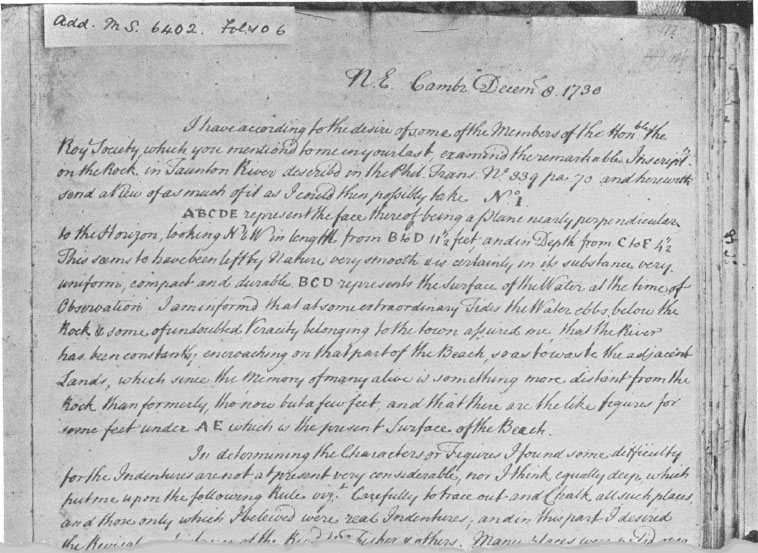
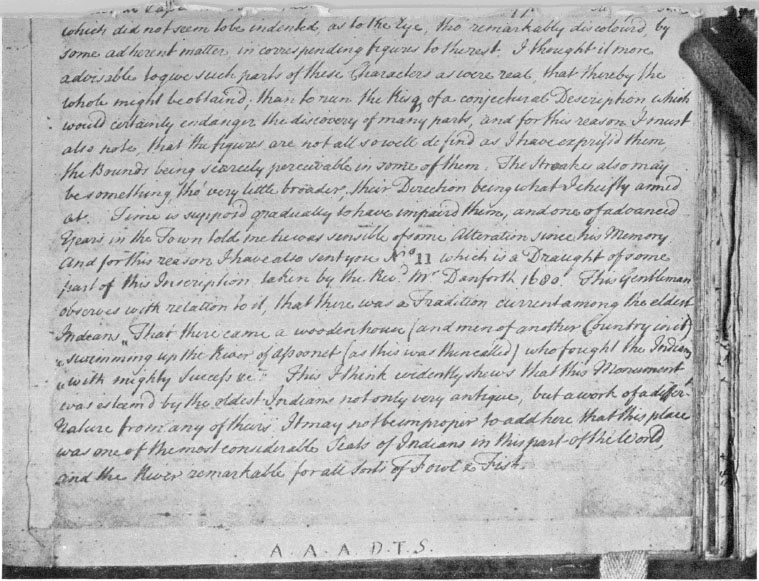
GREENWOOD LETTER A, DECEMBER 8, 1730
ENGRAVED FOR THE COLONIAL SOCIETY OF MASSACHUSETTS FROM THE ORIGINAL IN THE BRITISH MUSEUM, ADDITIONAL MANUSCRIPTS 6402.106
We can probably approximate very closely to the time when Mather secured this part of his drawing. In his Diary appears the following entry under the date of July 5, 1711: “There is one good Interest, which I have never yett served, and yett I am capable of doing some small Service for it. The Improvement of Knowledge in the Works of Nature, is a Thing whereby God, and his Christ is glorified. I may make a valuable Collection of many Curiosities, which this Countrey has afforded; and present it unto the Royal Society. May the glorious Lord assist me, in this Performance.”426 Dighton Rock had already engaged his attention as a curiosity, over twenty years earlier. Inasmuch as he proceeded to carry out the intention indicated in this passage, it is probable that this was the incitement to his endeavor to procure the remaining portions of the inscription. His interest being again engaged, and his intention to include the Rock among his “Curiosities” fixed, he would probably have sought to obtain the inscription complete after receiving what he understood to be a “second line” only out of many, had he had time before writing his letters. In fact in his letter he indicates his hope to succeed in this. It is fairly safe, therefore, to infer that this “second line” was procured after July 5, 1711, and very likely came to hand only very shortly before November 28, 1712.
Cotton Mather’s Broadside
Our next item in natural, and probably also in chronological order, is a very recent and in some respects important discovery. It is a little Broadside of uncertain date, shown in one of our plates. It has never been mentioned in any list of colonial broadsides, nor in any discussion on Dighton Rock. Two slightly differing copies of it are known to me. One is owned by the Massachusetts Historical Society, and for a long time this seemed a unique example. But recently I have discovered another among the Stiles papers in the Yale University Library, where it is bound into the collection of unpublished manuscript field-notes by Stiles, called his “Itinerary.” The former bears no indication of its date or origin. On the latter, however, Dr. Stiles wrote the following endorsement: “1766 Nov. — Dr Cotton Mather’s Acco sent to the Royal Society, & inserted in their Transactions abr. V. 5. 112. p. 4 Mr Chickly427 shewing me this in fall of 1766 first excited my Curiosity to examine the Rock.” The latter being a more perfect copy, is the one that I reproduce.428 The two are not identical. In the first, the cut of the inscription is printed below the descriptive matter; in the second, the position of the two is reversed. Hence either two separate editions of it were issued, or the printing of the one edition was interrupted, and resumed for some reason with the two portions in reversed positions. That the latter is more probable, appears from the fact that the type of the reading matter is identical, letter for letter and space for space — there are individual peculiarities about some of the letters that render this certain — and the individual types of the border likewise correspond exactly; hence the type remained set up in its original form instead of being distributed in the interval between the two impressions. The impression in the case of the first is more blurred and imperfect than in the other. Either it was printed later, after the cut and type were much worn, or the inking was less even and perfect. In all other respects the two are alike. The woodcut used was the same. Each is printed on a small piece of irregular shaped “laid” paper with no watermark, measuring 3¾ to a little over 4 inches in height, and 5⅛ to 5⅝ inches in width. The “first line” is about 3 3/32 inches long, the extreme width of the two lines is 1⅝ inch, and the space within the border measures about 1 5/16 by 3¾ inches.
It is not impossible that Cotton Mather himself may have issued this broadside either before or after his account was printed in Philosophical Transactions in 1714.429 So great was the interest aroused thereby, that it may well be that he caused this to be printed in order that he might distribute it to all who inquired concerning it. Certainly no adequate motive appears for its issuance at a later date by another person. Whether this be so or not, there is at any rate, even aside from Dr. Stiles’s testimony, no question that both words and drawing have Mather as their source. It may be that the particular paper used, or the particular border which surrounds the text, was in use at such a definite and limited time in some particular office of publication as to serve to establish the approximate date. It is certain that it is later than July 5, 1711, and earlier than November, 1766. Though there is no definite proof of it, it is probable that it was issued by Cotton Mather shortly after the appearance of the account in the Transactions in 1714.
It is interesting to compare the cut of the Broadside with the two drawings known to be by Mather. For this reason, besides giving a facsimile of the Broadside in Plate V, I have included the “first line” of the three, together with Danforth’s, in Plate VI. The Broadside is placed between the 1690 and the 1712 Mather versions; and in this case is reproduced from the one owned by the Massachusetts Historical Society. A careful study of the three Mathers line by line and figure by figure, gives many indications that the Broadside is an intermediate form between the other two. It is not safe to venture too confident an assertion in regard to this. But there are so many instances warranting this assumption, and so few that seem to indicate the opposite order of time in their execution, that it seems much more probable that the drawing from which the Broadside was derived antedates that from which the cut in Philosophical Transactions was made, than that the former was copied from the latter. It is possible that Mather had a drawing in 1712, which he copied for the Royal Society, and which he then used directly in the issuance of this Broadside to serve some purpose at home. But this is mere conjecture. Even if we should conclude with entire confidence that the drawing of the Broadside is earlier than the other it would not at all settle the question as to when the publication of it was made. It might have been long after, and by another hand. Nevertheless, for reasons already given, this is highly improbable.
The next event in our history is a brief and unimportant quotation from Mather’s Philosophical Transactions account, made by Daniel Neal in 1720. He makes a mistake in saying that this letter of Mather’s was written to Dr. Woodward. The passage is as follows:
Dr. Mather in a Letter to Dr. Woodward says, that at Taunton by the Side of a Tiding River there is a large Rock appearing above Water, on the perpendicular Side of which next the Stream are seven or eight Lines about seven or eight Foot long, and about a Foot wide, engraven with unaccountable Characters, not like any now known in the World.430
Dean Berkeley’s Visit to the Rock
Although it has required a long survey to establish the facts thus far, yet we can see that up to about 1730, nearly a hundred years, probably, after it was first seen by the colonists, very little notice had been taken of Dighton Rock. Only one drawing of the upper part of it existed, made by John Danforth in October, 1680; and only a questionable one of its lower portions, made by some one unknown and so unskilled that it is impossible to be sure that it really represents this Rock, and first known of as in possession of Cotton Mather in November, 1712. Of verbal description, we have only a few words attributed to Danforth, and a very brief and inadequate account by Cotton Mather. The year 1730, or thereabout, brings us three further contributions, all of them important. Two of these we now introduce into the discussion of Dighton Rock for the first time. The other is well known, but even in its case new facts have been discovered which remove a considerable confusion and inaccuracy previously existing. The three incidents referred to are: a visit to the Rock by the Rev. George Berkeley, D.D., then Dean of Derry but temporarily residing in Newport, afterward Bishop of Cloyne and one of the most deservedly eminent of English philosophers; a visit to the Rock and a drawing made of it by John Smibert (or Smybert), one of the earliest of American portrait painters; and another visit, resulting in a rather indifferent drawing and the first detailed discussion of the Rock, by Isaac Greenwood, “Hollisian Professor of ye Mathematicks and Philosophy” at Harvard College.
Plate IX
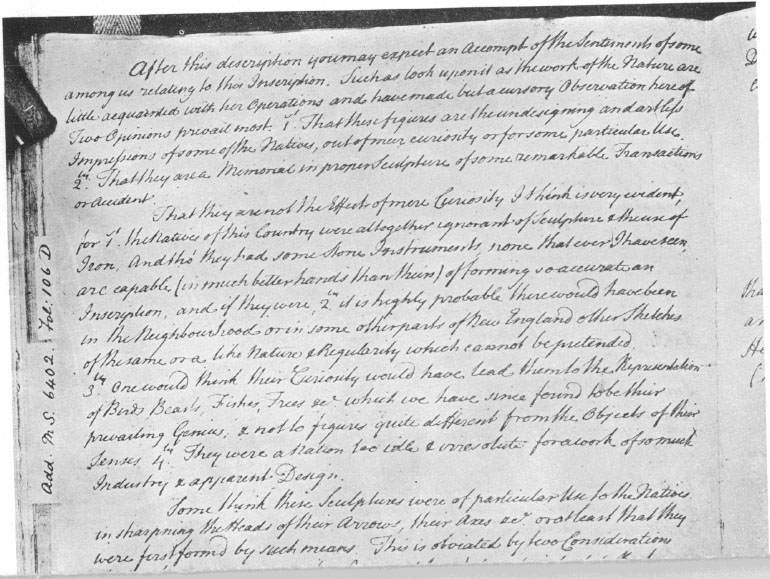
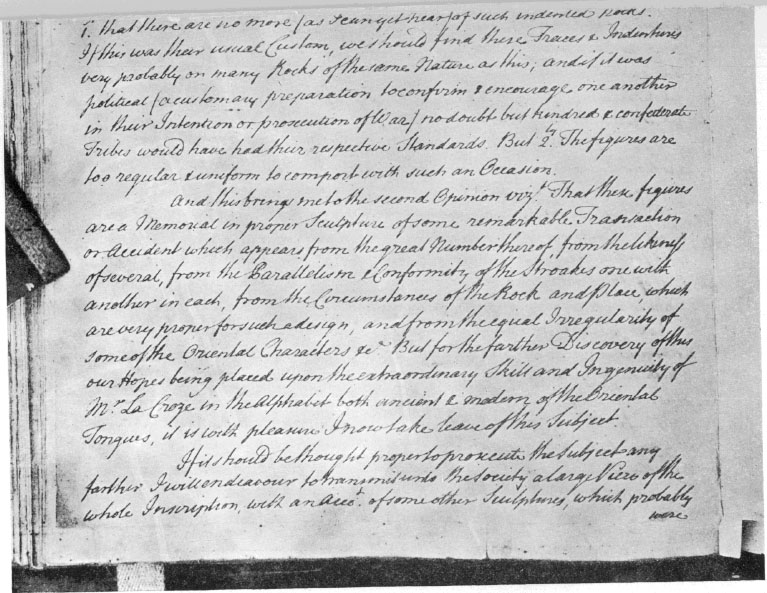
GREENWOOD LETTER A, DECEMBER 8, 1730
ENGRAVED FOR THE COLONIAL SOCIETY OF MASSACHUSETTS FROM THE ORIGINAL IN THE BRITISH MUSEUM, ADDITIONAL MANUSCRIPTS 6402.106 DORSE
I have found three obscure accounts of Berkeley’s visit, that have escaped the notice of the biographers of Berkeley and of previous writers on Dighton Rock. One is in a manuscript written by Pierre Eugène du Simitière about 1781;431 a second in the English Review’ for 1790; and the third in the unpublished Itinerary of Dr. Ezra Stiles, under date of 1767.
Du Simitière’s paper is headed: “Inscriptions in North America.” The portion dealing with Dighton Rock is entitled: “Inscription in Massachusetts.” After quoting from Neal and Douglass, and speaking of his visit to Dr. Stiles of Newport, he proceeds:
there is a tradition very current in New England, but particularly at New Port that when the learned Dean Berkeley resided near that last mentioned place about the year 1732432 he visited the rock at Taunton, and had began an Elaborate dissertation upon the supposed inscription, when a farmer in its neighborhood, observing the Dean one day employed in copying the unknown caracters, informed him, that, that rock had been used formerly by the Indians that resorted thither to Shoot ducks, and dart fish, to wett [whet] and Sharpen the points of their arrows and darts on that Stone which was the cause of the various hollow lines and figures formed thereon.
He then proceeds to refer to Gebelin’s Monde Primitif in such a manner as to show that the date of the manuscript is shortly after the publication of its eighth volume in 1781.
The paper by the Rev. Michael Lort, and another on the same subject by Colonel Charles Vallancey, in Archaeologia (1787, viii), were reviewed in the English Review for March, 1790. Concerning Berkeley’s visit to the Rock, the reviewer says:
In May 1728 the late Bishop Berkeley, that great and good man, went over to Boston. From thence he made an excursion, in order to examine these written mountains433 of America. He went to the rock. He examined the inscription. And, as we well remember to have been told by his ingenious and religious widow, the late Mrs. Berkeley, he returned fully convinced that this reputed scrawl of the present Indians, this boasted inscription of Punick, of Phœnician, or of Tartar hands434 was merely the casual corrosion of the rock by the waves of the sea. With this opinion, unknown as it appears to have been to Dr. Lort, we cordially concur.435
After reading this review, Dr. Lort wrote to the Rev. Thomas Percy, Bishop of Dromore, as follows:
Saville Row, April 16, 1790. . . . Now comes a reviewer in the last “English,” and says, we are mistaken; that the late Bishop Berkeley went on purpose to see it, and found it the work of the wind, waves, and weather corroding the rock, and I am very much disposed to be of this hypothesis; but what will Colonel Vallancey say to it? However, I shall try to get a more authentic account of this opinion of Bishop Berkeley’s.436
This is all that we know in detail as to Dean Berkeley’s visit; though we have one more confirmatory authority to cite. The two accounts do not agree concerning his theory about the Rock. But they are in agreement as to the fact of his having seen it; and the reference to Mrs. Berkeley makes it very probable that the story is true in this respect at least. The plausibility of the event is further increased by the fact that we know on the authority of Fraser,437 and of the Biographia Britannica,438 that during his stay in Newport Dean Berkeley made many visits to neighboring places. Thus Fraser says: “We learn, on Mrs. Berkeley’s authority, that ‘when the season and his health permitted, he visited the Continent [of America] not only in its outward skirts but penetrated far into its recesses.’” Moreover, the theory which Du Simitière represents Berkeley as accepting so readily is one related by Greenwood in 1730 as actually current at the time, as we shall see in our later discussion of Greenwood’s contribution.
These probabilities are turned into certainty by the testimony of Dr. Stiles, whose knowledge was derived from one who was probably an actual witness of Berkeley’s visit. On June 5th and 6th, 1767, Dr. Stiles, then minister at Newport, made a visit to the Rock. He records the fact on page 280 of his Itinerary, an unpublished manuscript in possession of the Yale University Library. The passage reads as follows:
Was taken off first by Dr. Cotton Mather. Then by Professor Greenwood. — Lastly by Dean Berkley. Greenwd took the whole; the other two but half. Teste Benj Jones aet. 70 Owner of the Rock.
This Benjamin Jones came into possession of the land on which the Rock stands in 1720.439 He dwelt on the property, and died there in 1768.440 That he personally saw both Berkeley and Greenwood when they severally came to copy the inscription is rendered plausible by the fact that “a farmer in its neighborhood” told Berkeley about the rock being used by the Indians in sharpening their arrowheads, and Greenwood relates the same legend. It is very likely that both learned of it from the same source, and that Benjamin Jones was the “farmer” in question. His knowledge of Mather, however, would have been by hearsay only, and the fact that he said the latter had copied only half the inscription seems to show that he confused him with Danforth. Stiles himself, of course, knew of Mather’s description; but that he knew nothing of either Danforth or Greenwood, whose drawings were not published until 1787, is shown by the following passage in a letter441 which he wrote on June 15, 1767, to Professor John Winthrop: “Mr. Jones . . . told me, the whole was formerly decyphered or taken off by Mr Professor Greenwood your Predecessor. If, Sir, his drawing be in your hands, or in possession of the College, pray oblige me with a pencil’d copy.”
Plate X
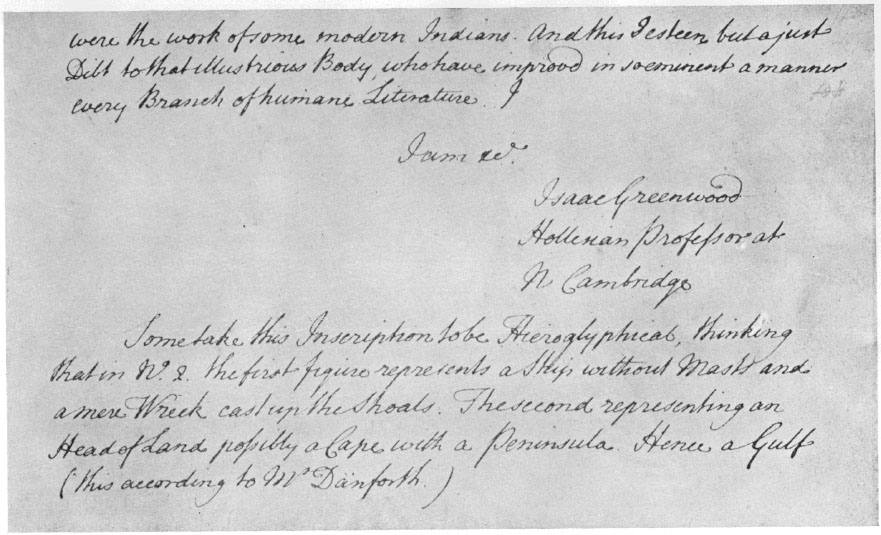
GREENWOOD LETTER A, DECEMBER 8, 1730
ENGRAVED FOR THE COLONIAL SOCIETY OF MASSACHUSETTS FROM THE ORIGINAL IN THE BRITISH MUSEUM. ADDITIONAL MANUSCRIPTS 6402.107
All of this renders it highly probable, therefore, that Jones had personal knowledge of Berkeley’s visit, and makes his testimony practically conclusive as to the fact of the visit and the truth of Du Simitière’s account of it. It adds the further fact that Berkeley copied about half of the inscription.
It is impossible to fix the exact date of the incident; but it must have been, of course, some time between his landing at Newport on January 23, 1729, in furtherance of his project to found a college for the education of Indian youths in the Bermudas, and the time of his abandonment of that project and departure for England on September 21, 1731.442
John Smibert and the Rock
That so gifted an artist as John Smibert made an early drawing of Dighton Rock is, if true, a fact of the highest importance. We have knowledge of it only through the same manuscript of Du Simitière that has already been referred to. In a footnote to the passage already quoted, the writer adds:
there was in the collection of Doctor Smibert at Boston, an accurate drawing of the Supposed inscription at Taunton, done by his father John Smibert an eminent painter that came over to america with Dean Berkeley, and afterwards Settled at Boston.
This is a meagre and tantalizing record. If this drawing could be found, it would be for many reasons the most interesting and important of all. Considering the incompleteness of the Danforth drawing, the utter badness of Mather’s, and the incompleteness and poor artistic merit of Greenwood’s, it doubtless would be the earliest good delineation of the characters made. But search in many directions has failed to discover it, and no writer on the Rock has known of its existence.
A report that I read somewhere to the effect that the Boston Smiberts later removed to England led me to make inquiries as to present-day families of that name. I found one such family now living in Scotland, and another in Australia. Letters to both of them received courteous replies. But neither of them know of the existence of the drawing in question.
However, John Smibert died in Boston, and so apparently did all his children, of whom he is known to have had four.443 An inventory of the estate left by him, dated September 22, 1752, is on file,444 and makes no mention of the drawing that we seek. His real estate all went to his eldest son, Dr. Williams Smibert, who must have been the “Dr. Smibert” referred to by Du Simitière. In his own will, dated January 17, 1770, and proved January 28, 1774, he describes himself as a “Doctor in Physick,” and as the “last that survives” his parents and their offspring.445 Williams Smibert’s estate was willed to his cousin, John Moffat; and through other steps we can trace the descent of whatever may have been left of John Smibert’s property in this line to people of still other names.446 In all this course, there is no clue to the fate of the drawing.
However, another son, Nathaniel, also survived the father for a few years. He was born January 20, 1735,447 and died in Boston, November 3, 1756.448 Before his death he, too, had become a painter of promise, and it may be that the father’s paintings and drawings, some of which are known to have been left in the studio, became his property.449 The statement of Du Simitière, however, makes it improbable that the drawing of Dighton Rock was among those that remained in the studio after Nathaniel died.
We must regretfully leave the subject of Smibert in this disappointing condition. I have thought it worth while to mention all the clues in my possession, in the hope that some one else may follow them out to a successful issue. The time of Smibert’s visit would very likely have been in 1729, since he arrived in Newport with Berkeley in January of that year and left there for Boston late in the same year. This is the most probable period for his visit to the rock.
There is one other report concerning Smibert which, while it has nothing to do with his drawing, nevertheless shows his interest in the Indians, and has served as an item of evidence for one theory concerning the origin of the Dighton inscription. The facts are first related, so far as I know, by Dr. Stiles in his Election Sermon of 1783.450 But they are most fully given in the following account written by Josiah Meigs to Dr. Samuel L. Mitchill:
The question relative to the first peopling of this continent, has justly excited the attention of reflecting men. I have often heard the late excellent Doctor Ezra Stiles, President of Yale College, relate the following anecdote: When Doctor Berkeley, Bishop of Cloyne, arrived at Newport, in Rhode-Island, about the middle of the last century, with a view of establishing a seminary of learning in America, he had with him, as a companion and friend, a Mr. Smibert, a celebrated painter of the Flemish school. In a few days after their arrival, Mr. Smibert saw in the streets a number of Narraganset Indians. At the first sight of them he expressed great surprise, and asked how those Tartars came there? On being asked why he called them Tartars, he replied, that, some years before, when he was at Florence studying his profession, the Grand Duke of Tuscany had received, as a present from the Sovereign of Russia, several Tartars, who had been taken prisoners: that he, Mr. Smibert, had been employed in drawing their portraits; and that their features were so much like those of the Narragansett Indians, that he was perfectly confident that they were of the same family and race.
I need not observe, that a painter’s business is to observe, with the most minute accuracy, the features of the human face, and that the conjecture of a migration of Tartars from the Eastern shores of Asia to our Northwestern region, is considerably strengthened by this anecdote.451
Plate XI
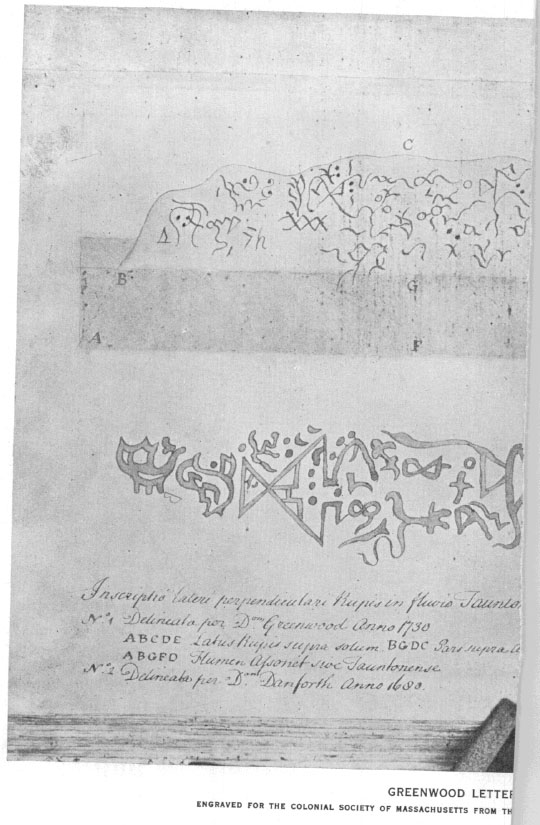
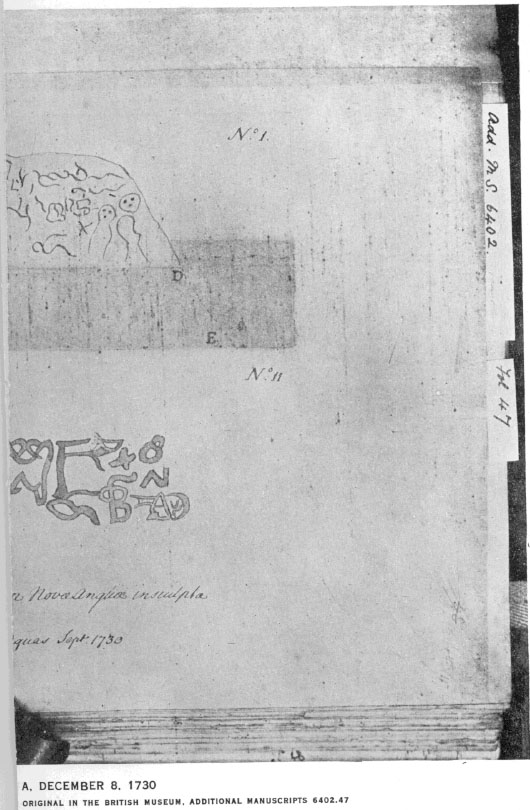
Isaac Greenwood’s Drawing, 1730
We reach at last the final source of information concerning Dighton Rock during the period with which we are dealing. When I first approached this subject, there seemed every reason to believe that our information concerning Isaac Greenwood and his important contribution was practically complete. As has been shown in dealing with the question of Danforth, Lort had quoted extensively from Greenwood and depicted his drawing; Bushnell had found Greenwood’s original letter and reproduced it fully, with a photograph of its drawings; and Baxter had given a small item of further information. But a little further inquiry showed a remarkable amount of uncertainty and confusion. Baxter’s quotation seemed to indicate an unexploited source of information. Various indexes to the Manuscripts in the British Museum seemed to give conflicting data. Dates were given variously; several different recipients of the letter were indicated; the British Museum references, if all of them were correct, implied a wealth of unused material.
The puzzling degree of confusion that actually existed can be exhibited best by a survey of all the facts concerning Greenwood’s contribution that were accessible in print. These will be presented in the chronological order of their publication.
1. The Catalogue by Samuel Ayscough,452 1782, mentions Greenwood’s letters twice, as follows:
Volume I, p. 355: “4432.55. James Greenwood. Inscriptions in New England, 1730, 1732.”
Volume I, p. 450: “J. Greenwood. 4432.55. Inscriptions in New England. 1730–32.”
2. The Rev. Michael Lort,453 in 1787, was the first to publish either the whole or a portion of a letter from Greenwood, together with the drawings accompanying it. The account referred to by Ayscough was already in the British Museum. Lort, however, did not discover it, but took his version from the Minutes of the Society of Antiquaries of London for the year 1732. He says that the letter was addressed to the Rev. Mr. Villan, Rector of St. John’s Tothillfields, and submitted to the Society of Antiquaries in 1732 by Mr. Bogdani. Its date was 1730.
3. Madden’s Index454 of 1849 has this entry: “Greenwood (Isaac), Hollesian Professor at N. Cambridge. Letter concerning an inscription on a rock in the river Taunton, in New England, etc., 1730. 6402. ff. 44, 112.”
4. James Phinney Baxter,455 in 1887 and 1889, gives a brief quotation, evidently from Greenwood or from some one who gives a similar account of Danforth’s opinions. He does not name the writer, but it might be inferred from what he says that it was the Rev. Mr. Fisher. The letter was addressed, he says, to Sir Hans Sloane, bears the date December 18, 1730, and is in the Sloane Manuscripts in the British Museum. It is accompanied by drawings. His quotation contains one sentence (“they slew yr Saunchim”) not found in Lort’s version of Greenwood. It seems most probable, however, that the writer is Greenwood, and that either Lort omitted this sentence or it is a second letter from the same hand.
5. Scott’s Index456 to the Sloane Manuscripts makes no mention of anything by Greenwood, or of the inscription in Taunton River.
6. Andrews and Davenport’s Guide457 of 1908 catalogues a “Communication from Is. Greenwood, Cambridge, Dec. 8, 1730, regarding Inscriptions on the Rock in Taunton River, with two drawings,” under Add. MSS. 4432. f. 182.
7. David I. Bushnell458 in 1908, having found two letters from Greenwood in the British Museum, printed them both in full, with a photographic reproduction of accompanying drawings by Danforth and Greenwood. The manuscripts from which he made his transcripts belonged once to the Royal Society, he tells us, but are now preserved in the British Museum. The first letter bears no address, is dated Dec. 8th, 1730, and signed “Isaac Greenwood,” and is numbered Add. MSS. 6402, fol. 106 et seq. It is accompanied by drawings, whose reference number is not mentioned by Bushnell. The second letter is addressed, he says, to Mr John Evanses, Fellow of the Royal Society, and contains words which imply that the first letter was sent to the same person. Its date is April 28, 1732, its signature “J. Greenwood,” and its reference number is given inadequately as MS. Vol. 4432, British Museum. We shall discover later that the accuracy of these transcripts cannot be relied upon.
Except that it contains much more than was given by Lort, this letter might be the one that was copied in the Minutes of the Society of Antiquaries in 1732, from which Lort derived his copy. But if so, either the Antiquaries or Lort transcribed it only in part, and very carelessly. On the other hand, it could not be the same letter as the one quoted by Baxter, unless both Lort and Bushnell omitted the sentence concerning the “Saunchem,” or Baxter was mistaken in saying that there was such a sentence in the letter.
8. Although the above is all that I could discover in print, I will add to the list of data on record when my own investigations began the following, from a letter that I received from Mr. Bushnell:
I remember having seen another letter from Greenwood, bearing date Dec. 8, 1730, which, at that time, I regarded as an early copy of the one preserved in Vol. 6402, fol. 106 et seq. The latter I copied and reproduced in the Anthropologist. Now the “copy” of the letter, if copy it really is, was in the volume with the short note of April 28, 1732. . . . I do not know to whom the copy was addressed.
To facilitate their readier comprehension, I recapitulate these facts in tabular form. Since it is impossible to tell from them whether there is one letter or more of 1730, sent to one correspondent only or to several different ones, bearing only one date or more, I designate any letter of 1730 as X, without any implication as to their identity. The letter of 1732 I call Y, and the drawings Z. The abbreviation S.A.L. indicates the Society of Antiquaries of London; and B.M., the British Museum. O indicates that nothing is reported.
| Authority | Document | Date | To Whom Addressed | Where Preserved |
|---|---|---|---|---|
|
Ayscough |
XY |
1730–1732 |
Not mentioned |
B.M., 4432.55 |
|
Lort |
XZ |
1730 |
Rev. Mr. Villan |
Minutes S.A.L. 1732 |
|
Madden |
X |
1730 |
Not mentioned |
B.M., 6402, ff. 44, 112 |
|
Baxter |
XZ |
Dec. 18, 1730 |
Sir Hans Sloane |
B.M., Sloane MSS |
|
Scott |
O |
|||
|
Andrews |
XZ |
Dec. 8, 1730 |
Not mentioned |
B.M., Add. MSS. 4432. f. 182 |
|
Bushnell |
X |
Dec. 8, 1730 |
Not given; presumably Mr. John Evanses |
B.M., Add. MSS. 6402. f. 106 et seq. |
|
Bushnell |
Z |
Not mentioned |
||
|
Bushnell |
X |
Dec. 8, 1730 |
Not known |
B.M., MS. Vol. 4432 |
|
Bushnell |
Y |
Apr. 28, 1732 |
Mr. John Evanses |
B.M., MS. Vol. 4432 |
Here are three correspondents mentioned, three dates, and six reference numbers in the British Museum with three others left indefinite. This state of affairs naturally invited investigation. Through the kindness of Mr. Albert Matthews, I secured the assistance of a careful worker in the British Museum, to whose efficient labors I am indebted for a complete clarification of the entire problem. Through her, I have had search made for all the Greenwood material in the Museum, and have secured photostats of all that is there; and have had the records of the Royal Society examined. In addition, through the courtesy of Mr. H. S. Kingsford, Assistant Secretary of the Society of Antiquaries of London, I have obtained a transcript of the record in the Minutes of that Society for 1732, and a description of the drawings copied into the Minutes.
Plate XII
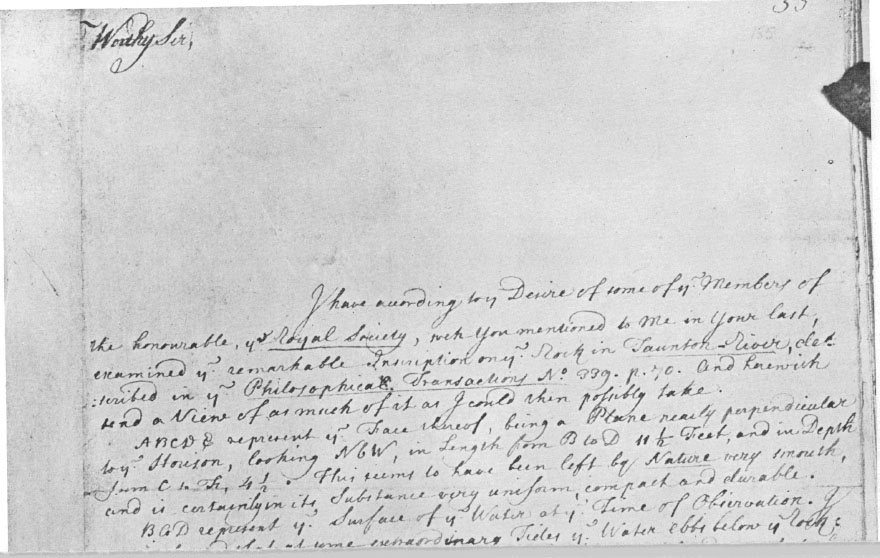
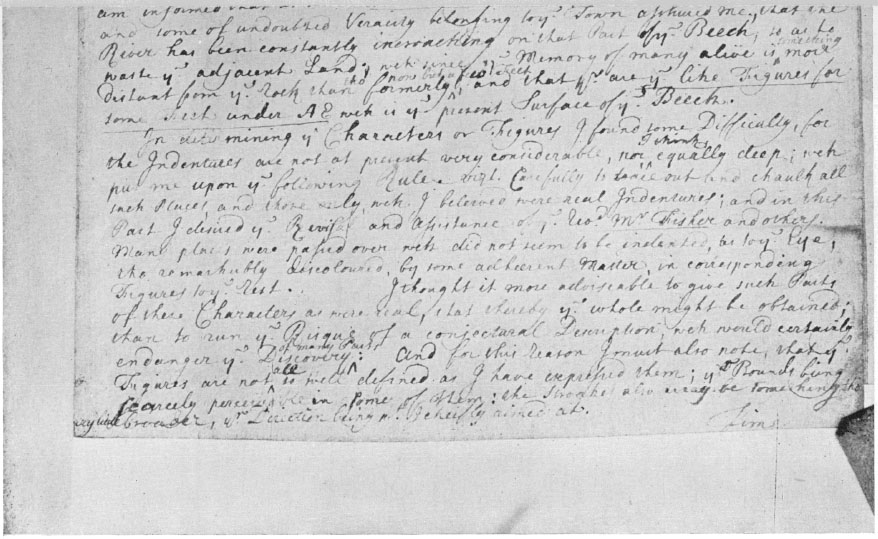
GREENWOOD LETTER B, DECEMBER 8, 1730
ENGRAVED FOR THE COLONIAL SOCIETY OF MASSACHUSETTS FROM THE ORIGINAL IN THE BRITISH MUSEUM, ADDITIONAL MANUSCRIPTS 4432.185
Probably the most remarkable fact that we have to record in connection with the inadequacies of previous investigation is that no one has yet correctly named the correspondent to whom Greenwood addressed his letters. The name Villan, given by Lort, was a mistake for Viller, as it stands in the “Minutes,” and this name itself is incorrect.459 The mention of Sloane is due to a mistaken inference. “Evanses” is an incorrect rendering of the actual name, “Eames.”
The real facts, mingled with a very small amount of inference that seems entirely justified, can now be related. Some time before December 8, 1730, Professor Greenwood received from Mr. John Eames, a Fellow of the Royal Society, a letter stating that some of the members of the Royal Society, interested by Cotton Mather’s description in the Philosophical Transactions of 1714, wished to secure a new copy of the inscription on the rock in Taunton River.460 Accordingly, Greenwood visited the Rock and copied its inscription. He already had in his possession, or now obtained, either the original or a copy of Danforth’s drawing of 1680, and a slip of paper — whether written by Danforth, by himself, or by some one else, it is impossible to say — containing Danforth’s brief description. Greenwood copied the two drawings onto one sheet of paper, and composed a descriptive letter in reply to Eames. This letter (which we will hereafter call Letter B), however, was at first a rough draught only, with numerous corrections, erasures, and interlineations. Of this he then made a fair copy (Letter A), differing very slightly from the corrected original, markedly better in its handwriting and spelling, and containing most of the contents of the “Danforth slip” in a postscript. He sent the “fair copy” (Letter A)461 and the copied drawings to Eames probably at about the time of its date, December 8, 1730. He retained in his own possession the original draught, the two original drawings, and the “Danforth slip.”
In April, 1732, he learned from Eames that the latter had never received a reply to his previous letter with its request for the drawings.462 There being a ship about to sail immediately, Greenwood, with no time to make another copy, prepared the materials concerning the rock which he had retained for himself in 1730: the original rough draught of his letter, the original drawings, and the “Danforth slip.” Together these constitute what we will now call “Letter B.”463 They bear the original date of December 8, 1730, but were sent to Eames in 1732. With them he sent also a brief and hurried letter of explanation, dated April 28, 1732, which we designate as “Letter C.”464
The only possible doubt about this part of our story concerns the order in which the two letters were sent. But when we consider, first, that if a man makes two copies of a letter, the one a rough draught and the other a fair and perfect copy, it is the latter that he sends to his correspondent, retaining the rough draught for his own use; second, that Greenwood was in haste when he sent the duplicate letter, and so would have been less likely then than at the earlier date to have made a fair copy of the materials he had on hand; third, that the rough draught, slip, separated drawings, and letter of 1732 are still preserved together; and fourth, that Letters B and C were copied together on the same date into the Register Book of the Royal Society, — we cannot escape the conclusion that our account thus far is correct. Particularly important is the resulting conclusion, that the drawings accompanying Letter B, never heretofore published, if not the original Danforth and Greenwood drawings, are at least one step nearer the originals than are the drawings of Letter A, which Bushnell photographed and published and which Lort copied at second hand; and the further conclusion that the “Danforth slip,” if not written by Danforth himself, nevertheless gives us our nearest approach to Danforth’s own statement.
Letters B and C arrived in London June 5, were received by Eames, and were presented by him to the Royal Society, where they were read on June 15, 1732; and on the same day the two letters and the drawings were copied into the Register Book of the Royal Society. Eventually they passed into Birch’s collection of manuscripts and by 1782 were in the British Museum. Here they were registered at first, as we can show, under the number 4432, division or article 55. Later they became Add. MSS. 4432, at first with folio numbers 182–186 and perhaps 187, but now with folio numbers 185–190. Although Lort thought that he had made a thorough search of the records of the Royal Society, he failed to discover this entry in its Register Book, as well as the original letter, already in the British Museum.
Before November of 1732, Letter A, the fair copy originally sent by Greenwood to Eames, had also arrived. This letter is the one that was exhibited to the Society of Antiquaries of London by Mr. Bogdani. Mr. Eames, who was a member of the Royal Society, may have sent it to the other Society through the Rev. Mr. Villers.465 It was certainly not addressed to the latter. The dorse of its last sheet was not used for the address, and the sheet used as an envelope is not preserved. An excerpt from the letter, and the drawings, were copied into the Minutes of the Society of Antiquaries on November 9, 1732. This letter apparently came into the possession of the Rev. William Cole, who bequeathed the volume in which it is contained to the British Museum in 1783. The drawings are known as Add. MSS. 6402 folio 47, and the letter as Add. MSS. 6402 folios 106 and 107.
Some of my photostats show clear evidence of the changes in numbering to which the letters have been subjected. Thus the first sheet of Letter A has three numbers in its upper right hand corner, all of them probably too faint to show clearly in the plate which is herewith reproduced from it. The number highest up is “112.” Underneath it is “107” crossed out, followed by “106.” Consequently Madden’s reference to this letter as numbered 112 was once correct, although the folios now numbered 44 and 112 in volume 6402 contain entirely unrelated matters. Madden’s “44” may be an error, since the three successive numberings shown on the drawing are “48,” “46,” and now “47.” Nearly all the folios of Letters B and C show a “55” very plainly. On the folio containing the Greenwood drawing it is reversed, as if made on the back and showing through the paper. It may have been once on the folios where it is now missing and been cut off, as some of them have been trimmed. This “55” is the division number given to these two letters by Ayscough. Besides the “55,” the first folio of Letter B has a rather faint “185,” its present number; and a very faint “182” crossed out — the number by which Andrews refers to it. The triple numbering is shown more plainly on the last folio (189) of Letter B than on any of the others. With the exception of Madden’s “44,” therefore, the only error as to numbering and place of preservation that occurs in the table submitted above is that made by Baxter in saying that the letter he found was in the Sloane Manuscripts; Scott is correct in not listing it there.
Plate XIII
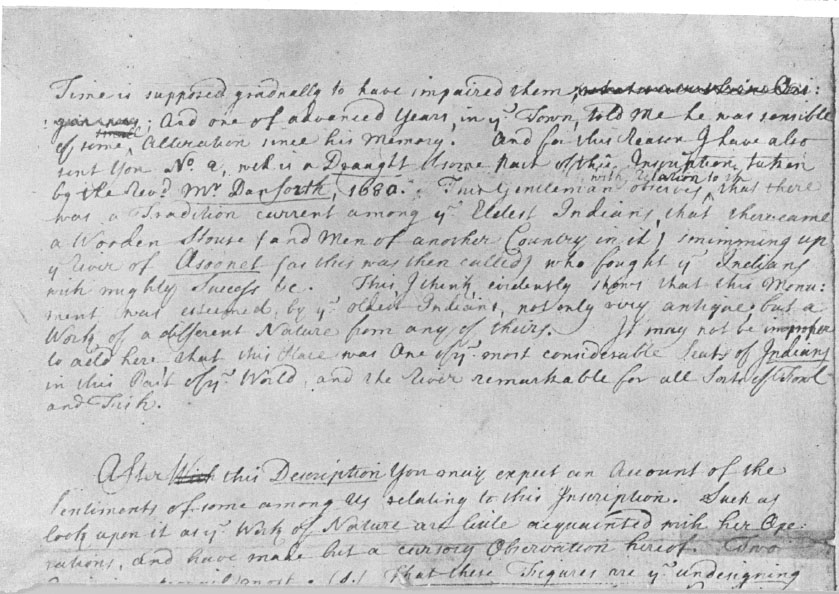
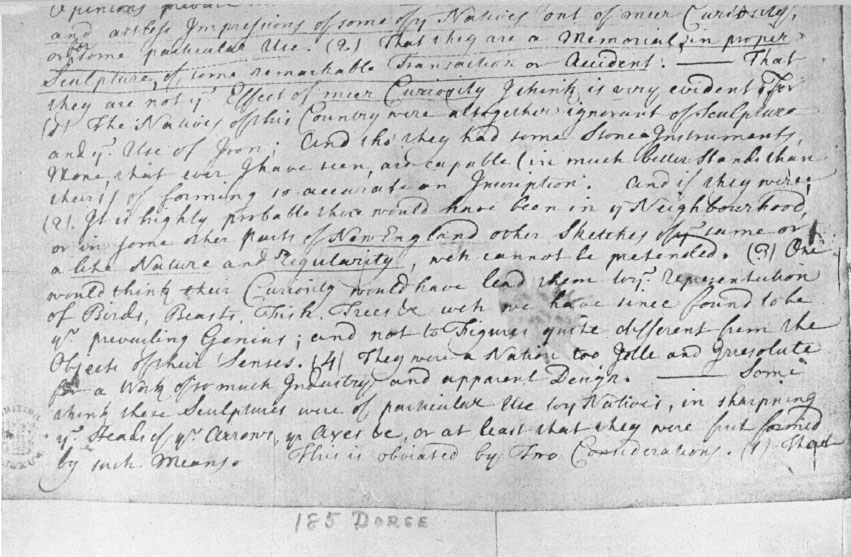
GREENWOOD LETTER B, DECEMBER 8, 1730
ENGRAVED FOR THE COLONIAL SOCIETY OF MASSACHUSETTS FROM THE ORIGINAL IN THE BRITISH MUSEUM, ADDITIONAL MANUSCRIPTS 4432.185 DORSE
It is clear that there was but one recipient for all three letters, — Mr. John Eames.466 The introductory paragraph, together with Letter C and its address, proves that all were addressed to the same person. So also does the entry in the Register Book of the Royal Society, described below. How it came about that his name has never been mentioned and three wrong ones given has already been discussed.
The discrepancy of the reports as to date is explained by the photostats and plates in an interesting manner. Letter A is clearly dated, at the beginning, “Decem. 8. 1730.” The date in Letter B is placed at the end, and is also “Decemb. 8 1730.” But before the “8” is a faint additional stroke, not nearly so black and thick as every other letter and number in the line, and not at all like the “1” in “1730.” Not only Baxter, but the clerk who copied the letter into the Register Book of the Royal Society, as we shall see, thought that this was “18;” but Andrews correctly calls it “8.”
Our plates reproduce in facsimile from photostats all the Greenwood documents in the British Museum.467 Besides the actual contents of the letters, they show a considerable number of other features of interest. First of all, there is the great difference in style and handwriting in the two letters of 1730. One is fair, neat and deliberate in its calligraphy, with no erasures or corrections; the other presents a very different appearance, more hurried, careless and irregular. The rough draught has many erasures, interlineations, and underlinings which do not appear in the other. It also uses freely the contracted forms “ye, yt, yr, wch,” etc., and such spellings as “Beech,” “meer,” “asshured,” etc., which the other presents in a more scholarly manner. The “Worthy Sir” close to the top at the beginning of Letter B escaped the notice of the Royal Society copyist. The handwriting of the “Danforth slip” it is hard to judge. It might be Greenwood’s more careless style. But it seems somewhat different from that, and probably it is by some other hand, even Danforth’s own.468 The “No. 2” at the bottom was unquestionably placed there by Greenwood to correspond to the number by which he named Danforth’s drawing in the text. Probably, also, the “n” in “Taunton” was inserted by Greenwood. The dorse469 of the last sheet of Letter B (folio 189) contains only the stamp of the British Museum, and the indorsement: “June 15, 1732. Tr. Copied.” For this reason, though I have a photostat of it, I have not reproduced it among the plates. The indorsement refers to the date when the letter was copied into the Register Book of the Royal Society; though what the “Tr.” means, I do not know.
The dorse of Letter C (folio 190) is an interesting study.470 It was originally folded, of course, and served as envelope for Letters B and C together. Two wax seals — probably Greenwood’s — are clearly shown. It is addressed: “For Mr. John Eames. Fellow of ye Royal Society &c. London. To be left with Mr. Thos. Hollis Merchant in ye Minories. Per Capt Winslow.” It is stamped with a “5” and “IV” enclosed in a circle with a horizontal diameter, — probably the stamp of the postal authorities, indicating the fifth day of the fourth month. The letter arrived in London, therefore, on the 5th of June. Intermingled with the address are three not very legible marks, that may also have been written there by postal clerks. The upper one is probably “1 oz” — the weight of the letter. The next looks like IN 5 or IIV 5; yet the character in the middle probably is not an N or a V. Could it be “11 shillings 5 pence” for postage?471 The last might be three faint initials — possibly “ADC,” and conceivably the initials of the mailing clerk. There are, further, two endorsements. One is that of the Royal Society copyist: “June 15, 1732. Copied.” The other has “June 15, 1732” and “Inscription in N. Engld.” in two different handwritings. Finally there is the stamp of the British Museum.
Plate XIV
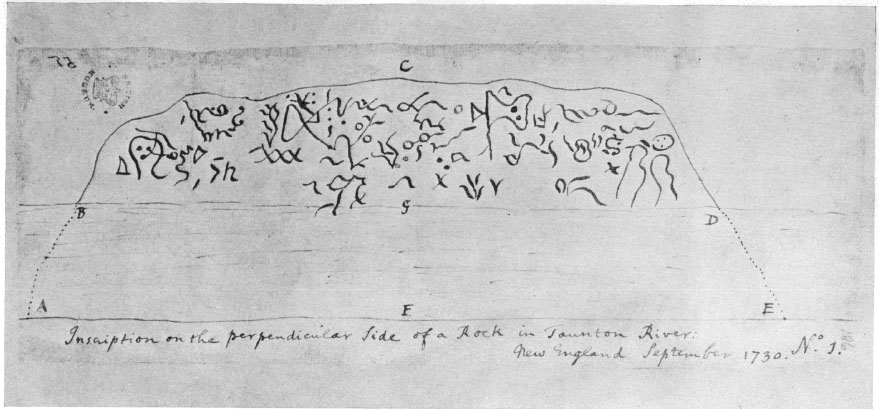
GREENWOOD LETTER B, DECEMBER 8, 1730
ENGRAVED FOR THE COLONIAL SOCIETY OF MASSACHUSETTS FROM THE ORIGINAL IN THE BRITISH MUSEUM. ADDITIONAL MANUSCRIPTS 4432.186
Underneath the drawings of Letter A, Greenwood wrote a description in Latin. We have already seen, in our discussion of Danforth, how his Latin abbreviation for “Mister” (Dom) misled the person who copied the drawings into the Minutes of the Society of Antiquaries, and led every one thereafter to speak of “Dr.” Danforth and “Dr.” Greenwood.
Isaac Greenwood’s Letters and Drawings
We can now consider the actual contents of the letters and of the drawings, and the different versions of them that have been recorded. We will consider the drawings first. As has been already said, those of Letter B (4432 f. 185 et seq.) may possibly be the original by Danforth and the original by Greenwood; though of this we have no sufficient evidence.472 If copies, they nevertheless certainly are nearer to the originals than any others in existence. Yet they have never before been reproduced. Our modern versions are all derived from the copies of these that Greenwood made and sent with Letter A (6402 f. 47). From Greenwood’s copies they were first copied into the Minutes of the Society of Antiquaries, then from that source they were copied by Lort and published in Archaeologia, which in turn has been the source of all later reproductions except Bushnell’s. There are many slight and a few important differences between the “originals” in B, the “Greenwood copies” in A, and the copies by Lort.473 In the Danforth drawing, for instance, there are several cases of lines joined together in B which become separated in A, or separated in B which become joined in A. The faint “BI” near the left in B has become a clearer, but still linear, “B” in A. A little distance from the right end there is a small linear square in B and none in A. Finally, and most striking of all, a part of the third figure from the right at the top, above the square just mentioned, is clear and perfect in B, but has suffered a blot or smear in A. Lort follows practically all the characteristics of A except that he gives the whole in outline. He even preserves the unintended blot, as have all subsequent copies. In the Greenwood drawing, there are even more cases of difference in the joining or separating of lines; the proportions are visibly different; the water has been more artistically presented in A; the second apparently human figure from the right end has no dots for eyes and mouth in B, but has them in A; the first triangular figure from the left has an included character in A, which was lacking in B. Lort naturally follows nearly all the characteristics of A, though he omits so elaborate a presentation of the water and shore, in a very few cases approaches more nearly the line-meetings of B, and once at least, in the lines running to eye and mouth of the head at the left, he differs from both. His own statement, his mistake about the “Dr.,” and the above facts, all concur in proving that his copies were made from the Minutes of the Society of Antiquaries, whose drawings were copied from Letter A.
The contents of the letter are almost identical in the two cases. The main difference is that what was a separate slip included in the rough draught, B, has become a postscript in A. Because A is so clearly legible in the plates, and has already been transcribed, though imperfectly, by Bushnell, we will here give a transcript of the original draught only, Letter B, and will exhibit the differences between the two in another connection.
Worthy Sir,
I have according to ye Desire of some of ye Members of the honourable, ye Royal Society, wch You mentioned to Me in Your last, examined ye remarkable Inscription on ye Rock in Taunton-River, described in ye Philosophical Transactions No 339. p. 70. And herewith send a View of as much of it as I could then possibly take.
ABCDE represent ye Face thereof, being a Plane nearly perpendicular to ye Horison, looking N b W, in Length from B to D 11½ Feet, and in Depth from C to F, 4½. This seems to have been left by Nature very smouth, and is certainly in its Substance very uniform, compact and durable.
BGD represent ye Surface of ye Water at ye Time of Observation. I am informed that at some extraordinary Tides ye Water ebbs below ye Rock: and some of undoubted Veracity belonging to ye Town asshured me, that the River has been constantly incroaching on that Part of ye Beech, so as to waste ye adjacent Land; wch since ye Memory of many alive is something more distant from ye Rock than formerly tho’ now but a few Feet, and that yr are ye like Figures for some Feet under AE wch is ye present Surface of ye Beech.
In determining ye Characters or Figures I found some Difficulty, for the Indentures are not at present very considerable, nor, I think, equally deep; wch put me upon ye following Rule. vizt. Carefully to trace out and chaulk all such Places, and those only, wch I beleived were real Indentures; and in this Part I desired ye Revisal and Assistance of ye Revd Mr Fisher474 and others. Many places were passed over wch did not seem to be indented, as to ye Eye, tho remarkably discoloured, by some adheerent Matter, in corresponding Figures to ye Rest. I thought it more adviseable to give such Parts of these Characters as were real, that thereby ye whole might be obtained; than to run ye Risque of a conjectural Description, wch would certainly endanger ye Discovery of many Parts: And for this reason I must also note, that ye Figures are not all so well defined as I have expressed them; yr Bounds being scarcely perceivable in some of Them: the Stroakes also may be something tho’ very little broader, yr Direction being wt I cheifly aimed at.475
Plate XV
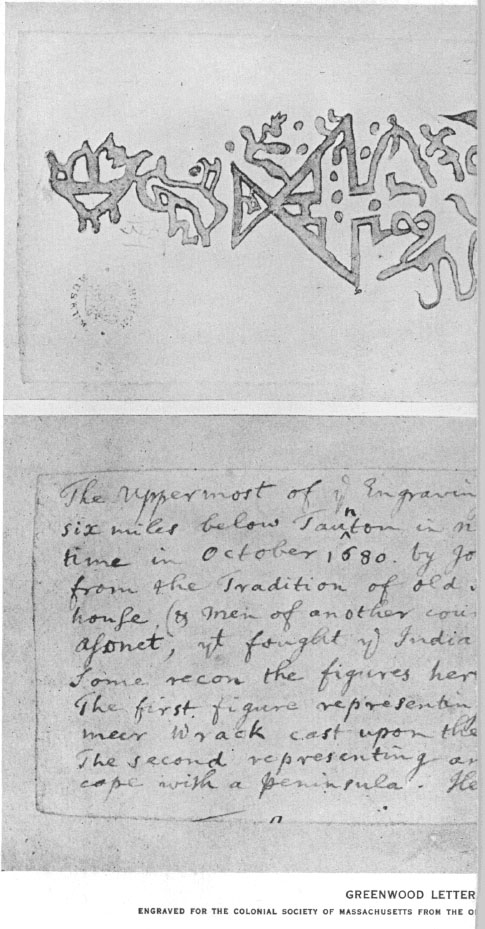
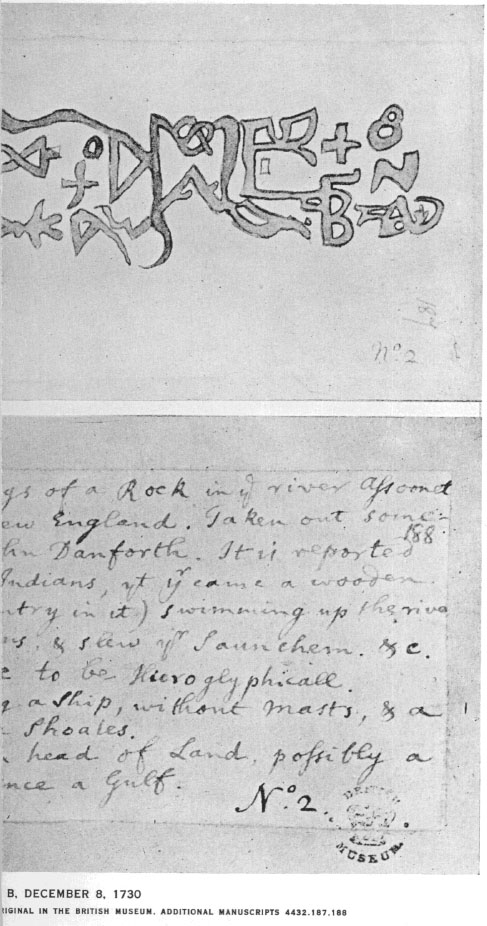
Time is supposed gradually to have impaired them; And one of advanced Years, in ye Town, told Me he was sensible of some Alteration since his Memory. And for this Reason I have also sent You No. 2, wch is a Draught of some part of this Inscription taken by the Revd Mr Danforth, 1680. This Gentleman observes with relation to it that there was a Tradition current among ye Eldest Indians, that there came a Wooden House (and Men of another Country in it) swimming up ye River of Asoonet (as this was then called476) who fought ye Indians with mighty Success &c. This, I think, evidently shows that this Monument was esteemed, by ye oldest Indians, not only very antique; but a Work of a different Nature from any of theirs. It may not be improper to add here that this Place was One of ye most considerable Seats of Indians in this Part of ye World, and the River remarkable for all Sorts of Fowl and Fish.
After this Description You may expect an Account of the Sentiments of some among us relating to this Inscription. Such as look upon it as ye Work of Nature are little acquainted with her Operations, and have made but a cursory Observation hereof. Two Opinions prevail most. (1.) That these Figures are ye undesigning and artless Impressions of some of ye Natives out of meer Curiosity, or for some particular Use. (2.) That they are a Memorial, in proper Sculpture, of some remarkable Transaction or Accident. — That they are not ye Effect of meer Curiosity I think is very evident. For (1) The Natives of this Country were altogether ignorant of Sculpture and ye Use of Iron; And tho’ they had some Stone Instruments, None, that ever I have seen, are capable (in much better Hands than theirs) of forming so accurate an Inscription. And if they were; (2). It is highly probable there would have been in ye Neighbourhood, or in some other parts of New England other Sketches of ye same or a like Nature and Regularity, wch cannot be pretended. (3) One would think their Curiosity would have lead them to ye Representation of Birds, Beasts, Fish. Trees &c wch we have since found to be yr prevailing Genius; and not to Figures quite different from the Objects of their Senses. (4) They were a Nation too Idle and Irresolute for a Work of so much Industry and apparent Design. — Some think these Sculptures were of particular Use to ye Natives, in sharpning ye Heads of yr Arrows, yr Axes &c, or at least that they were first formed by such Means. This is obviated by Two Considerations. (1) That477 there are no more, as I can yet hear, of such Indented Rocks. If this was their usual Custom we should find these Traces and Indentures, very probably, on many Rocks of ye same Nature as this; And if it was Political, (a Customary Preparation to confirm and encourage One Another in their Intention or Prosecution of War), No doubt but kindred and Confederate Tribes would have had their Respective Standards. — But (2) The Figures are too Regular and uniform to comport with such an Occasion. And this brings Me to ye Second Opinion vizt. That These Figures are a Memorial, in proper Sculpture, of some remarkable Transaction or Accident. Which appears, from ye great Number thereof; from ye Likeness of several; from the Parallellism and Conformity of ye Stroakes, one with Another, in each; from ye Circumstances of ye Rock and Place, wch are very proper for such a Design; and from ye equal Irregularity of some of ye Oriental Characters &c. — But for ye furthur Discovery of this, our Hopes being placed upon ye extraordinary Skill and Ingenuity of Mr La Croze,478 in ye Alphabets, both ancient and Modern, of the Oriental Tongues, it is with pleasure I now take Leave of this Subject.
If it shall be thought proper to prosecute ye Subject any furthur, I will endeavour to transmit unto ye Society a large Veiw of ye whole Inscription,479 with an Account of some other Sculptures wch probably were the Work of some Modern Indians. And this I esteem, but a just Debt to that Illustrious Body, who have improved, in so eminent a manner, every Branch of Humane Literature.
I am, Worthy Sir, Your Obedt Huml Servt
Is: Greenwood
Camb. Decemb. 8 1730.
It thus appears that Greenwood was of the opinion that the inscription was not the work of Indians, and that it contained Oriental characters. This view was greatly developed in detail and ardently advocated some fifty to seventy-five years later in several forms. Vallancey believed it the work of Siberian Tartars who had emigrated from Asia to America; Stiles, that these Tartars were descendants of the Canaanites expelled by Joshua, and ancestors of the Indians, but that the inscription was made by Phœnicians; Gebelin, that it was the work of Carthaginian sailors; Mathieu, that it was due to a Prince of Atlantis; Dammartin, that it was by Egyptians; Samuel Harris, that it contains Hebrew words; and Ira Hill, that it was done by Jewish and Tyrian sailors during the reign of King Solomon. But the exposition of these theories belongs to a later chapter of this history.
With this letter were sent the two drawings on separate sheets, and the “Danforth slip,” which Greenwood had retained with the rough draught, when he sent off the copied letter and drawings in 1730. The “Danforth slip” reads as follows, with what are apparently Greenwood’s own two additions to it placed in brackets:
The Uppermost of ye Engravings of a Rock in ye river Assoonet480 six miles below Tau[n]ton in New England. Taken out sometime in October 1680. by John Danforth. It is reported from the Tradition of old Indians, yt yr came a wooden house (& men of another country in it) swimming up the river Asonet, yt fought ye Indians, & slew yr Saunchem. &c.
Some recon the figures here to be Hieroglyphicall. The first figure representing a Ship, without masts, & a meer Wrack cast upon the Shoales. The second representing an head of Land, possibly a cape with a peninsula. Hence a Gulf.
[No. 2]
Greenwood’s Letter C, which enclosed this rough draught, Letter B, sent to replace his Letter A which had failed to reach its destination, was as follows:
NE. Camb. April 28 1732.
Hon. Sir
I perceive by Yours that a Packet I sent to You upwards of a Year since miscarried in wch was an Answer to Your Request relating to ye Inscription on ye Rock at Taunton. I am loth by this First Opportunity to omit sending a Coppy thereof, And with Thanks to you for Your Favours, I am with all due Respect,
Your Obliged Humble Servt.
I: Greenwood
If it shouldbe thought proper to make it public, I shouldbe glad You’l would see that ye Title Hollisean be placed before Profess. of ye Mathematieks and Philosophy at Camb. NE.
Please to excuse my Brevity, for I am but just now informed that ye Vessel is immediately to sail.481
The address and other features that appear on the back of this sheet, which was used as an envelope in which to send both Letters B and C through the mail, reveal the name of his correspondent, and have already been discussed.
On the 15th of June, 1732, Letter B was read, presumably by Eames, to the Royal Society, onto whose Register Book for 1731–32 it and its enclosures were copied at once. In the margin of the Register appears: “Read, June 15: 1732.” On the letter itself, as well as on Letter C, was endorsed: “June 15, 1732. Copied.” The copy in the Register Book is headed: “An Account of an Inscription in unknown Characters found on a Rock in Taunton River, in New England: communicated in a Letter to Mr John Eames F. R. S. By Mr Isaac Greenwood, Hollisian Professor of the Mathematieks & Philosophy at Cambridge in New England. Dated Cambr: Decembr 18. 1730.” Then follows the copy of the letter itself, exact as to wording, apparently (only the beginning and the end of it have been transcribed for me), but differing in such particulars as the use of abbreviations, the substitution of “the” for “ye,” the use of capitals, etc.
Plate XVI
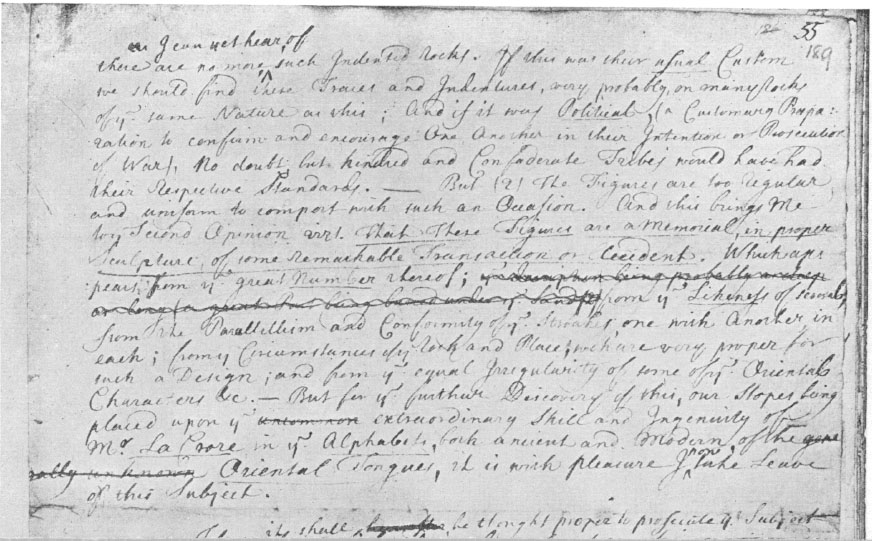
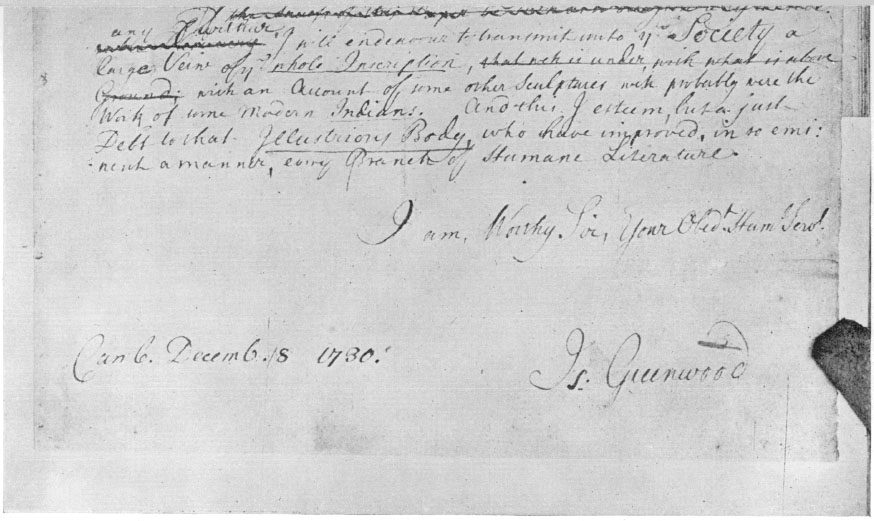
GREENWOOD LETTER B, DECEMBER 8, 1730
ENGRAVED FOR THE COLONIAL SOCIETY OF MASSACHUSETTS FROM THE ORIGINAL IN THE BRITISH MUSEUM, ADDITIONAL MANUSCRIPTS 4432.189
The two drawings have been copied onto a piece of paper, with the appropriate description written under each, and this paper has been pasted into the book. Underneath the Greenwood drawing, in the hand of the clerk who copied the letter, is the description that appears in Greenwood’s hand on the drawing in Letter B; but to it is added, in a small and crabbed writing apparently by another hand:
|
ft |
|
|
length From B to D |
11½ |
|
Depth from C to F |
4½ |
B.C.D. represent the surface of the water at the time of Observation.
Underneath the Danforth drawing, in the crabbed hand, are reproduced the contents of the “slip,” with mention of “John” Danforth, of “October” 1680, and of the “Saunchem,” which prove that it was Letter B, not A, that was here copied, and that these now new facts might have been announced already by Lort, had he thoroughly searched the records of the Royal Society. The two drawings are very like their originals; but the dots representing eyes and mouth have been inserted in the head of the second figure from the right in the Greenwood drawing, though lacking in the original. This is a natural error, rendered more natural by suggestion from the neighboring figure, and not evidence that it was the drawing of Letter A that was being copied.
The Minutes of the Royal Society for 1732 could not be examined by my correspondent, as they were already stored away with other manuscripts and pictures as a precaution against a possible Zeppelin raid; but the Secretary said he should not expect anything to be there, when the original was copied into the Register.
After Letter A arrived, as it eventually did, it would appear that Mr. Eames thought that the Society of Antiquaries of London would be interested in the new information. It seems probable that he gave this accidentally duplicate letter to the Rev. Mr. Villers, who, through Mr. Bogdani, submitted it to the Society of Antiquaries, to whom it was read at a meeting held November 9, 1732. The drawings and about half of the letter were copied into the Minutes of the Society, where they are still accessible.482 The copy is preceded by the following introduction:
Mr. Bogdani produced a Drawing from a Rock in the River Taunton in New England drawn by Dr Greenwood 1730 & another of the same by Dr Danforth 1680 together with a letter from Dr Isaac Greenwood Hollesian Professor at New Cambridge to the Rev. Mr — Viller Rector of St — Tottlefields dat. N.E. Cambr. Dec. 8 1730, giving an account of the same as follows.
The excerpt omits the introductory sentence, which gives the conclusive evidence as to the person to whom the letter was addressed. It begins with the second sentence, “ABCDE . . . ,” and ends at about the middle part of the letter with the words “. . . Fowl and Fish.” It is very faithful to the original, but presents a few differences in spelling and capitalization. The two illustrations, the Assistant Secretary of the Society informs me, are identical with Numbers 2 and 3 on Plate XVIII of Volume VIII of Archaeologia. Below the drawings in the Minutes is written the description in Latin as in Greenwood’s Letter A, except that “perpendicularis” is substituted for “perpendiculari,” “Nove” for “Novae,” “Dr” for “Dom” in both cases, and “Supera” for “supra” in the second case of its occurrence. Also the order of one line is changed.
For some reason, it was not “thought proper” by the Royal Society or others to make the letter public.483 Consequently the duplicate letters with their drawings and the records of the two Societies slumbered unknown for fifty years. It was not until Professor Stephen Sewall of Harvard College had made a new copy of the inscription in 1768; and a copy of this had been sent to M. Court de Gebelin in Paris, who, in the eighth volume of his Monde Primitif, published in 1781, pronounced the inscription Punic or Carthaginian; and Dr. Ezra Stiles, President of Yale College, in his Election Sermon of May 8, 1783, had supported Gebelin’s interpretation, — it was not until then that the first widespread interest in the mysterious rock since Mather’s time arose, and new public discussions of it began. It was President Stiles’s sermon that incited the Rev. Michael Lort, in 1786, to survey the history of the subject anew. He discovered, as he says, that copies of the Dighton inscription —
had been sent, at different times by different persons, both to the Royal Society and the Society of Antiquaries, though no notice had been taken thereof in the printed Memoirs of either Society, except a very slight one in the Philosophical Transactions for the year 1714; I have therefore, from the minute books of each Society, collected together these different accounts, and, together with the drawings which accompanied them, submit them [on November 23, 1786] to the inspection of this learned body [the Society of Antiquaries]; and by their means, if it shall be thought proper, to the world at large.484
From his paper, entitled “Account of an antient Inscription in North America,” all subsequent knowledge of Danforth and Greenwood has been drawn, until Bushnell published his transcript from the letter itself in 1908.
Since he searched only in the Minute Books of the Societies, Lort naturally failed to discover the entire letter with its ampler information, either in the Royal Society’s Register or in the British Museum. His transcript from the Minutes of the Society of Antiquaries, moreover, is rather careless. The difference in his drawings has already been noted. In the letter, he transfers the part beginning: “ABCDE . . .” to the end, himself beginning with the words: “I am informed . . .” In spelling, capitalization and punctuation, he diverges widely from his original. He presents many cases of changed order of words, such as: “at present are not” in place of “are not at present,” “may be also” in place of “also may be.” Occasionally he inserts words or changes the manner of phrasing. The more important differences of the latter sort will be indicated shortly.
Except for Baxter’s brief quotation in 1887 from the “Danforth slip,” in connection with which he gave no indication that its source was either Danforth or Greenwood, no further new information appeared concerning either of them until David I. Bushnell published his transcript of Letters A and C in full, in the American Anthropologist in 1908. Unfortunately this transcript is very unreliable. More than fifty errors of capitalization, punctuation, paragraphing, and spelling occur on his first page alone. Some even more serious errors will be indicated in a comparative table below. Nevertheless he has the merit of having been the first to give us the whole of either of the letters of 1730, or that of 1732, or to show accurately how Greenwood’s own drawings actually looked.
The table which follows exhibits some of the more important differences in the various versions of the letter of 1730. It pays no attention to differences in the use of capitals, punctuation, forms like “ye” or “&” and their equivalents, abbreviations, and the like, which are exceedingly numerous. It does not include all changes in order of words such as Lort frequently indulged in. It also omits consideration of the version in the Royal Society’s Register, since that has never, directly or indirectly, served as a source of information.
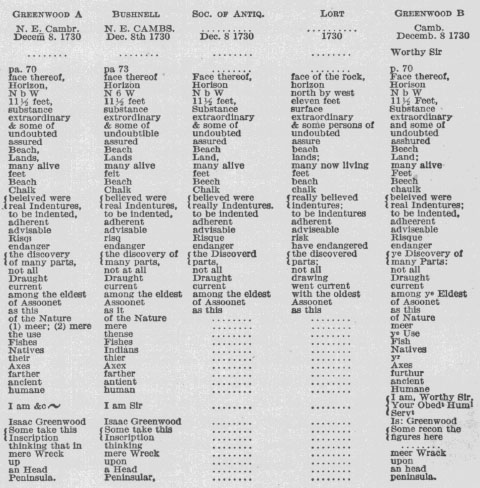
Plate XVII
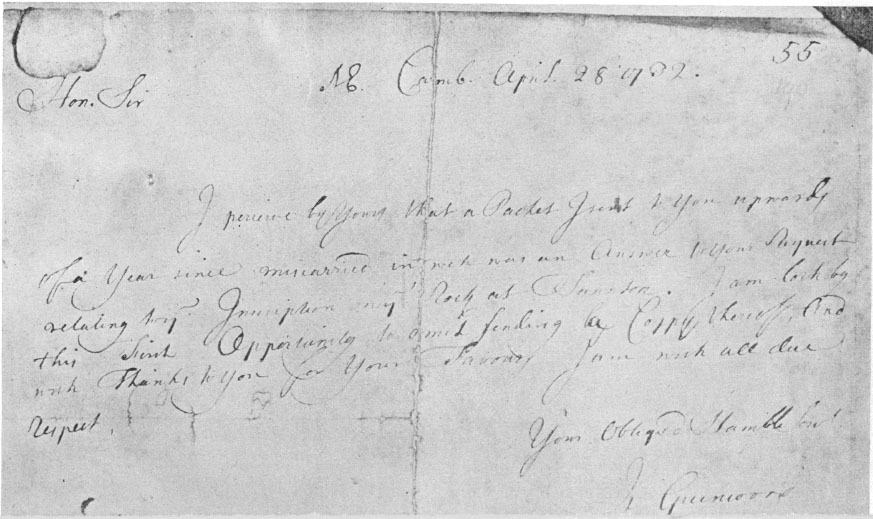
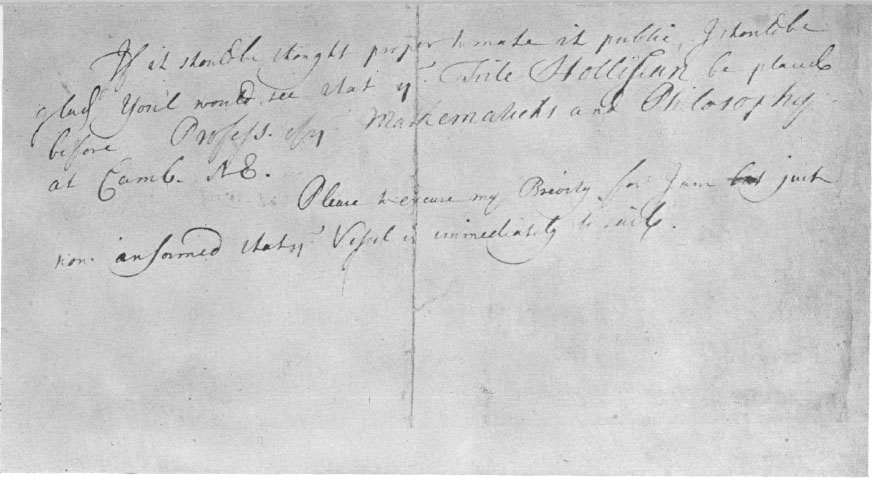
GREENWOOD LETTER C, APRIL 28, 1732
ENGRAVED FOR THE COLONIAL SOCIETY OF MASSACHUSETTS FROM THE ORIGINAL IN THE BRITISH MUSEUM, ADDITIONAL MANUSCRIPTS 4432.190
Conclusion
Our present task is at an end. The further history of delineation and discussion of the message of this cryptic rock is quite as full of interest, of variety, of uncorrected error, of forgotten theories, of unpublished or unassembled material, as that which we have surveyed. But its consideration must be reserved for another occasion. For the period that we have dealt with, covering about the first century of possible acquaintance with the rock by white men, we found at the start a very small amount indeed of reliable information. Although we are probably far from having attained ideal accuracy or from having discovered all possible sources of pertinent material, yet we have now approached toward this ideal quite materially. At the start, we found a number of positive statements concerning knowledge of the rock by the colonists, and absence of knowledge by the Indians. We can now quite as positively claim that no such statements are supported by evidence. Of historical facts, we had only these: that “Dr.” Danforth made a drawing in 1680, and the brief observation given in the body of Greenwood’s letter; that Cotton Mather gave out drawings apparently different from Danforth’s in 1690 and in 1712, and an exceedingly brief and empty description; that a brief phrase, discovered by Baxter, was to be added to Danforth’s account; that Greenwood made a drawing and wrote a letter in 1730, to a correspondent about whose identity conflicting claims have been made, of which an excerpt was published by Lort and a full transcript by Bushnell; and that another letter by Greenwood was written in 1732, and also transcribed by Bushnell. To these meagre and not wholly reliable statements we can now add a very respectable number of fresh discoveries. The Danforth was John Danforth, and the “Dr.” an easily explainable error. The date of his drawing was not 1688 or thereabout, as it seemed unavoidable to conclude from earlier probabilities, in spite of Greenwood’s statement, but really 1680, and in October. Cotton Mather’s “upper line” was not really new, but was a bad copy of Danforth’s; and his lower “line” is without a peer in misrepresentation. His own original letter of 1712 differs somewhat from its reproduction in the Philosophical Transactions. There exists a “Mather Broadside,” whose date we do not know. Samuel Sewall showed an interest in Dighton Rock in 1691. The rock was visited about 1730, not only by Greenwood, but by persons no less eminent than Dean Berkeley and John Smibert. Of the theories of Berkeley we are given some account. Smibert is said to have made a drawing, which seems to have entirely disappeared. The confused and conflicting statements about Greenwood and his letter or letters have been cleared up, the several versions of the letter traced to their sources, and the actual facts about it definitely determined.
Nevertheless we cannot close this chapter in the story of the tide-worn and controversy-worn Writing Rock with entire satisfaction. A number of unsolved problems remain on our hands, of which there is no reason to despair of a possible solution. Is there not somewhere existent definite information, besides the little we have gathered and earlier than Greenwood’s belated observations of 1730, about what use the Indians actually made of Assonet Neck? Did not some of the earliest settlers near-by make mention of the rock before 1680? Are there no letters or other papers by John Danforth himself, descriptive of his visit to the Rock? Is there no documentary proof of the source from which Cotton Mather obtained both the upper part and the lower part of his drawings? Who issued the “Mather Broadside,” and when, and for what reason? And where now is the lost Smibert drawing? It will be one of the happiest results of the publishing of this paper, if some or all of these questions may receive an answer.
List of Plates accompanying this Paper
- I Burgess Photograph of Dighton Rock, 1868, from an original in the possession of the Massachusetts Historical Society.
- II Best Known Drawings of Dighton Rock made before the Introduction of Photography, from the Tenth Annual Report of the Bureau of American Ethnology, 1893, Plate LIV.
- III Lort’s Reproduction of Danforth’s Drawing, 1680, from Archaeologia, 1787, VIII, Plate XVIII.
- III Cotton Mather’s Drawing, 1690, from Mather’s Wonderful Works of God Commemorated, 1690.
- IV Cotton Mather’s Drawing, 1712, from Philosophical Transactions, 1714, XXIX, No. 339.
- V Mather Broadside, from an original in the possession of the Yale University Library.
- VI Comparisons of the Danforth Drawing 1680, the Mather Drawing 1690, the Mather Broadside, and the Mather Drawing 1712.
- VII Lort’s Reproduction of Greenwood’s Drawing, 1730, from Archaeologia, 1787, VIII, Plate XVIII.
- VIII Greenwood Letter A, December 8, 1730, from the original in the British Museum, Additional Manuscripts 6402.106.
- IX Greenwood Letter A, December 8, 1730, from the original in the British Museum, Additional Manuscripts 6402.106 dorse.
- X Greenwood Letter A, December 8, 1730, from the original in the British Museum, Additional Manuscripts 6402.107.
- XI Greenwood Letter A, December 8, 1730, from the original in the British Museum, Additional Manuscripts 6402.47.
- XII Greenwood Letter B, December 8, 1730, from the original in the British Museum, Additional Manuscripts 4432.185.
- XIII Greenwood Letter B, December 8, 1730, from the original in the British Museum, Additional Manuscripts 4432.185 dorse.
- XIV Greenwood Letter B, December 8, 1730, from the original in the British Museum, Additional Manuscripts 4432.186.
- XV Greenwood Letter B, December 8, 1730, from the original in the British Museum, Additional Manuscripts 4432.187, 188.
- XVI Greenwood Letter B, December 8, 1730, from the original in the British Museum, Additional Manuscripts 4432.189.
- XVII Greenwood Letter C, April 28, 1732, from the original in the British Museum, Additional Manuscripts 4432.190.
- XVIII Greenwood Letter C, April 28, 1732, from the original in the British Museum 4432.190 dorse.
Plate XVIII
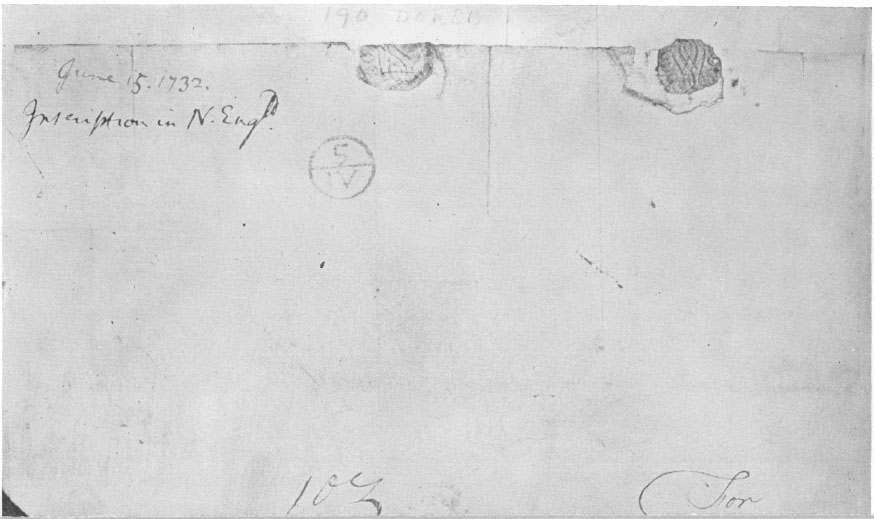
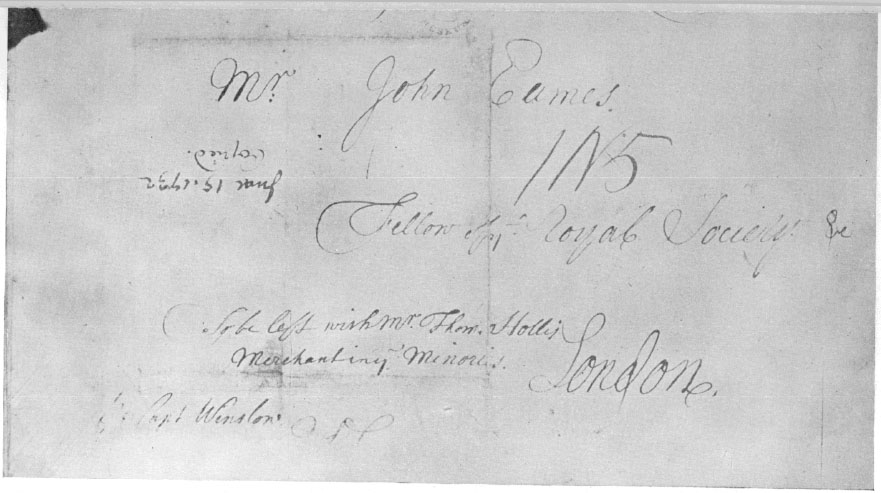
GREENWOOD LETTER C, APRIL 28, 1732
ENGRAVED FOR THE COLONIAL SOCIETY OF MASSACHUSETTS FROM THE ORIGINAL IN THE BRITISH MUSEUM, ADDITIONAL MANUSCRIPTS 4432.190 DORSE
Mr. Andrew McF. Davis read the following paper:
A CONFLICT IN THE OFFICIAL RECORDS
The fact that official publications of the State of Massachusetts furnish more than one date for the original charter of the town of Charlton, would not of itself furnish to others than those interested in the local history of the region a motive for an extended research among the archives and official documents of the Commonwealth in order to determine which was the right date, but when it appears that the date finally accepted at the State House is not the same as that given in the well-known publication entitled the Acts and Resolves of the Province of the Massachusetts Bay, the question rises in importance, for such points were not settled by those who had charge of that publication without careful examination. It happens that the Act establishing Charlton as a district was printed in the Province Laws before Mr. Goodell personally assumed the editorship of that publication, so that one may challenge the accuracy of the date given therein without impugning his judgment. Indeed, it is quite probable that he knew nothing about the steps taken at that time to determine this date, since his oversight of the work as Commissioner was interrupted during the preparation of Volume III for the press by protracted illness. At any rate, whoever may be responsible for it, there is doubt as to the accuracy of the date given in that volume for the establishment of the district of Charlton, and the circumstances which probably led to the acceptance of the one which was adopted are curious and interesting.
Towns were originally created in the Colony of Massachusetts without much formality, perhaps in consequence of doubt whether a mercantile company had power to create corporations of any sort, no matter what their nature. The one conspicuous violation of this proposition, the incorporation of Harvard College, took place in the days of the Commonwealth. Under the Province, the right to exercise this power seems to have been tacitly acknowledged and was freely exercised. The custom then grew up of engrossing on parchment the Acts creating new towns and of depositing these engrossed Acts in the archives. It follows that in cases where this step has been complied with, no question can arise as to the date of a charter. It happens that no such document is to be found in the archives in the case of Charlton. There is, however, in the hands of the town clerk of that place, what he himself terms “a contemporary copy of the original charter of Charlton,” and he adds: “The date of the Charter is Jan. 10, 1755.”485 It is probable that this date must be accepted, and it is reasonable to suppose that the doubts which have grown up about it would never have arisen, had the various investigators who sought to ascertain it applied directly to Charlton. Any person who has read the reports of the Commissioner of Public Records from year to year will understand why the town clerk’s office did not suggest itself as a place of inquiry concerning the date of a charter. The custody of the papers and records of the town was deputed to the care of the town clerk. Such a thing as a town safe was almost unheard of. Few of the town clerks realized the historical value of the papers placed temporarily in their hands, and as a result the documents were exposed to all sorts of vicissitudes in the various houses where they were from year to year deposited. If the records and papers of any town have been carefully preserved, it has been by rare good luck.
There are two official publications of the State of Massachusetts to which the ordinary investigator would naturally turn for information as to the date of a charter of a town established prior to the revolution. The first of these is the Manual of the General Court, which furnishes the date of the creation of all towns in the Commonwealth, and the second is the publication generally spoken of as the Province Laws. A third official source of information, not so generally known, is the report of Carroll D. Wright, Commissioner of Public Records. This was published in 1889 and contains information of the same character. It furnishes no new knowledge on the subject, since it refers to the Province Laws as authority for the date of incorporation of Charlton. There are, in addition, the contemporary publications of the laws passed during the provincial period, but these are classified by sessions and do not give the dates of the passage of specific acts.
The Manual is published annually for the benefit of the members of the General Court and contains, besides the names of the State officials and of the legislators, much condensed information as to the counties and towns in the Commonwealth. From time to time since this volume was first issued new tables have been added to its contents and it has now become a vade-mecum for the members of the legislature, without which they would be at a loss to know where to turn to gain the information contained in its pages. In 1871 the practice began of furnishing the dates of the charters of the towns in this Commonwealth, and, if originally incorporated as a district, the date of that incorporation. The date of a charter does not change from time to time, and presumably the date first inserted in the Manual should appear thereafter from year to year. Such was not the case, however, in regard to the charter of Charlton. From 1871 to 1891 inclusive, the Manual gives the date of that charter as November 2, 1754. From 1892 to 1900 inclusive, the date is given as November 21, 1754. From 1901 to the present time the date has been given as January 10, 1755.
Any person seeking for the date of this charter would necessarily assume its stability. He would, therefore, feel at liberty to quote the date given in any one of the forty-five volumes of the Manual containing this information. If by chance he sought to corroborate the date that he found by consulting the Province Laws, he would find that October 21, 1754, was the date of the passage of the charter according to that authority, a date which agrees with that given in eight only of these volumes.
If he should seek for explanation of these discrepancies he would find a possible explanation for the first date given in the Manual in the fact that this is the date given for the incorporation of the town of Charlton by Peter Whitney in his History of the County of Worcester.486 This work is a standard and is in its way reliable and fairly accurate, but is hardly to be accepted as a suitable basis for an official announcement of this kind in a State publication. It was published in 1793, and it is probable that the compiler of the table in the Manual in 1871, not finding the Engrossed Act in the archives, turned to Whitney’s pages for information as to the date. The language used in the History is: “This Town was taken wholly from Oxford, and was the westerly part thereof: It was incorporated November 2d, 1754, and then received its present name” (p. 221).
On the second of November, 1754, the legislation which finally resulted in the incorporation of Charlton as a district was in its preliminary stages and consisted merely of the appointment of a joint committee to consider the subject and make report thereon. The date given in the History must, therefore, have been an error, and probably was a compositor’s error. It is not unlikely that Whitney wrote November 21, a date for which authority is to be found in the Records of the General Court, for the statement which he made and the compositor when setting it in type mistook the numeral one for a letter d.
What was sufficient to satisfy a historian seeking merely for the first official record of an incorporation, no matter what its form, would not necessarily be enough for one, who, like the editor of the Province Laws, was seeking for the date of an incorporation of a district, the details of which were at his command in the pages of the contemporary publication of the perpetual laws. So far as he was concerned, there was no reason for choice between November, 1754, and January, 1755; but the thought suggests itself that a clue to the time of the passage of the Act might be inferred from its position in chronological sequence in the perpetual laws. If, however, we consult the preface to the first volume of the Province Laws, we find that the arrangement of the Acts in those volumes “is not strictly chronological, nor could it be made so without disarranging the order uniformly pursued in the early editions.” In other words, the clue fails us because the arrangement in the early editions is not strictly chronological.
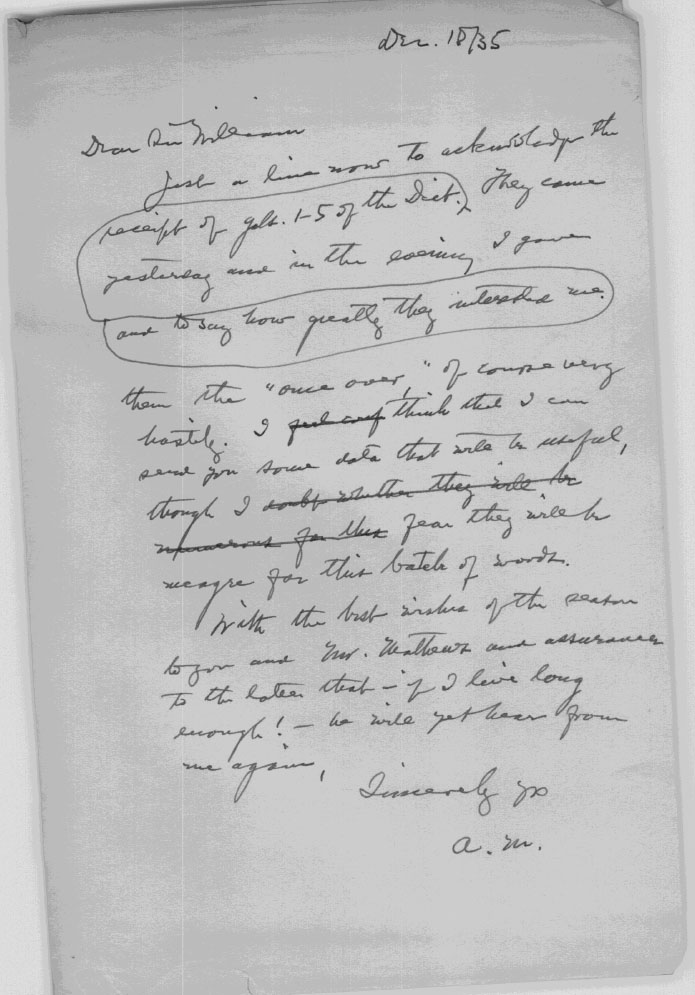
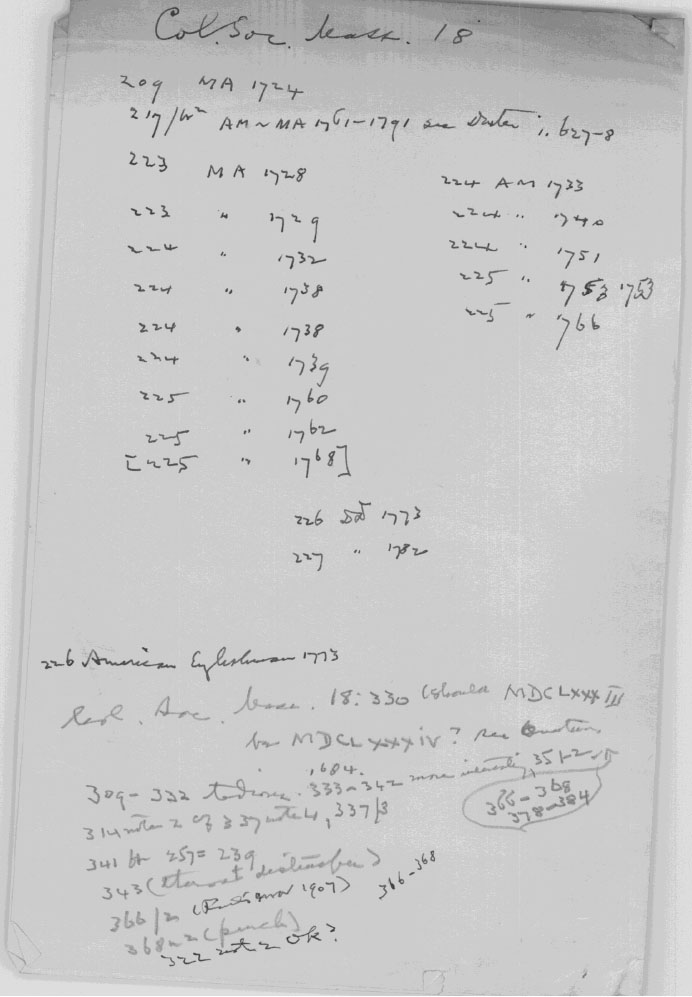
It is not essential to follow in detail the action of the General Court in reaching a final decision to incorporate Charlton as a district, but in order to understand how the date November 21, 1754, could have been selected for a result which apparently was not actually reached until January 10, 1755, it is important to examine some of those details. This examination will disclose certain unexpected features in the progress of the legislation as recorded in the official records which are in themselves interesting and call for explanation.
The matter first turns up in the Records, April 8, 1754, when a petition signed by William Allton and others, inhabitants of the west part of Oxford, setting forth the great distance of their homes from the body of the town and the inconvenience of attending worship there, and praying that they might be set off with their families and estates into a separate town or district, was presented to the General Court.487 Some of these people lived ten miles from the church which they were through taxation obliged to support.
There was no question that those thus situated were entitled to relief, and the town clerk of Oxford was ordered to appear at a given day and show cause why the prayer of the petition should not be granted. In due time the answer of the town clerk was filed and thereafter a joint committee was appointed which reported November 7, 1754, in favor of the petitioners. A bill was, on November 9, introduced in the House for setting off the inhabitants as also the estates of the westerly part of Oxford, and also the westerly part of the Country Gore, into a separate district by the name of, and a second reading was ordered for the next succeeding Tuesday. This is the last that is heard of this particular bill, but on the 13th of November a new bill was introduced in the House having similar import with the exception that its purpose was to incorporate the same persons and estates into a town by the name of. This bill was read a first, second, and third time, and was passed to be engrossed and was sent up for concurrence. In the Council it was read once on the thirteenth, twice on the fourteenth, and on the same day a concurrence was voted. These dates and these facts are taken from a copy of the bill to be found in the Archives.488
Under date of November 21, 1754, there is an entry in the General Court Records489 to the following purport: “An engrossed Bill, entitled an Act for setting off the inhabitants as also the estates of the westerly part of Oxford, as also the westerly part of the Country Gore into a separate town by the name of having been read three several times in the House of Representatives and in Council, Passed to be enacted by both Houses and signed by the Governor.” Here we have in the official records authority for the positive statement of the final passage of an Act incorporating a town, as yet nameless, but comprehending within its bounds the area known as Charlton.
In the Province Laws, the editor sought to append to each Act not only the date of its passage but also the date of the publication thereof, and the Commissioners quote, in a note to their preface to the first volume,490 from an order of the General Court in 1673 to the effect that all laws and orders of every session thought fit to be published should “be read in the Market Place, Boston, upon the fifth day being a lecture day, within ten days after the end of such sessions, which being performed is, and shall be accounted sufficient publication.” The official publication of Province Acts, whatever the method may have been, was not always easy to ascertain, and there are many in the different volumes of the Province Laws of which only the date of the passage could be learned. In such cases the editor was obliged to content himself with the date of the passage of the Act. The Act relating to the charter of Charlton is one of those which lack a date of publication.491 Whether the publication of the Act was an essential for its validity or not, it would seem as though this statement of the passage of the Act on the pages of the official document in which the doings of the General Court are recorded, was adequate to relieve Peter Whitney from the charge of having no basis for the date given in his History for the incorporation of Charlton, provided the conjecture is correct that he put down November 21 in his manuscript which was converted by the compositor into November 2d.
On the other hand, the person who decided the date in the Province Laws had several reasons for not accepting November 21 as the date of the passage of the Act actually published in Volume III of that publication. The language of the Act as given in that volume corresponds with the language used in a contemporary publication of the perpetual laws, in which the incorporation of Charlton is described as a district, and the territory included in that district does not comprehend the Country Gore — two vital differences. If we could say positively that reliance was had on the entry that we have quoted for the determination of the date given in that document, we should have a right to say that there was gross carelessness displayed in this acceptance. As matters stand we can only say that there is no other evident record upon which that opinion could have been based, and that being the case there is a probability that the date given in the Province Laws rests upon the record quoted. Had the editor examined the House Journal he would have found evidence, that notwithstanding the statement in the Court Records to the effect that the Governor had signed the bill, such was not actually the case. Under date of January 6, 1755, the following entry is made in the Journal:
Ordered, That the Secretary be directed to attend the House, who accordingly attended, and Mr. Speaker was pleased to ask him, Whether the bill for creating the westerly part of Oxford into a town was passed the Honorable Board, and signed by his Excellency the Governor?
Mr. Secretary informed the House that the Council had passed the Bill and that it had been laid before the Governor, and he had not signed it.
Thereupon a bill entitled “An Act for setting off the inhabitants as also the estates of the westerly part of Oxford into a separate district by the name of ” was read a first time.
It may be inferred from the rapidity of the action of the representatives in introducing a new bill that they already knew that the previous bill had been held up by the Governor and from the change of the form of organization in the new bill from town to district that they realized what his probable objections were. Perhaps also the dropping of the Country Gore may indicate a reason. Nothing appears in the records to indicate that objection was raised to the older bill by the residents of that section, but at a later date the inhabitants of the Gore vigorously resisted annexation to Charlton.
There is evidence existing that Governor Shirley was opposed to the incorporation of new towns, and it was in consequence of suggestions originating with him that “Additional Instructions” were prepared in 1743, authorizing the erection of “Precincts, Parishes or Villages” without the liberty of sending representatives to the General Court, but requiring the submission to his Majesty of bills for creating new or dividing old towns, before they should go into effect.492 Shirley had written to the Lords of Trade, a letter in which he recommended this proceeding and spoke of the effect that creating new towns had in “increasing the number of Representatives,” which he said “seems to promise no good effect for his Majesty’s service.” To prevent this increase he suggested that “Precincts, Parishes or Villages” might be erected with “all the Officers and Privileges of a Township except that of sending Representatives” to the General Court, thus securing for the petitioners for new towns the substance of their desires without violating the clause of the charter which provided that each town might have two representatives. It is evident from the use of the words “Precincts, Parishes or Villages” in the Instructions that those who framed them had Shirley’s letter in mind. For some reason the General Court seems to have preferred to call these new organizations districts rather than precincts, parishes or villages. It may be added that all districts were made towns by an Act passed August 23, 1775.
The protean bill, first introduced for the purpose of incorporating what was afterwards called Charlton into a district, then suddenly changed to the founding of a town and now posing as the creator of a district, must evidently have had its career influenced by Shirley’s well-known hostility to the erection of new townships, but why the representatives should have cared to select the township form for the organization of the place with all the delays necessarily inherent upon such a course is not clear. In seeking to make Charlton a town, they had first to overcome Shirley’s opposition, and if his acquiescence should be gained, they still had to encounter the delay caused by the submission of the bill to the Lords of Trade with the probability that opposition to its approval would develop in the Board. In any event the securing the approbation of the Board would take months.
If we now recur to this bill for “setting off the Inhabitants as also the Estates of the westerly part of Oxford into a separate District by the name of,” which was introduced in the House January 6, 1755, and then had its first reading, we find that it was amended on the 8th and read a second and third time and passed to be engrossed on the 9th. On the 10th the enactment is recorded in the House Journal, and on the same day the concurrence of the Council is recorded in the Court Records, the fact that it had been signed by the Governor not being stated.
The Act was printed on pages 466 and 467 of the laws of the session begun May 29, 1754, and continued by adjournment to October 17, 1754. No specific date is given for the passage of the bill. It was not included in the edition of the perpetual laws published in 1759.
The contemporary copy of the charter in the hands of the town clerk seems to be the most conclusive authority as to the date of the charter. The record of the enactment of the bill is corroborative, even though there is no statement that the Governor had signed it, but it is evident that those who have had to determine officially what that date was have had at their hands a perplexing question to settle.


 . It is not in keeping with the rest of the drawing, and looks almost as if it did not belong there. Yet Lort and all his successors accepted it as real and made it conform to the rest of the drawing. So also did Cotton Mather in 1690, though he made it look like a 9, not a B. But on this “original” Danforth drawing of Letter B (4432) it is much fainter than on the copy that Mather made and on the other copy that Greenwood made for Letter A. Moreover, it is not merely a B, but apparently a BI, and it clearly is not a part of the drawing itself, but an extraneous mark. Now it is a curious coincidence that these very initials are cut on another stone on the same property within half a mile from Dighton Rock. The owner of the rock at the time of Danforth’s visit in 1680, and again when Cotton Mather obtained his first drawing about 1689, was James Walker, a prominent man in Taunton, one of the original purchasers of Assonet Neck in 1677. In 1690, he deeded his property there to two daughters (see Bristol County, Massachusetts, N. District Land Records, Book 2, p. 242), one of whom in 1695 became the wife of Benjamin Jones (Memorial of the Walkers of Old Plymouth Colony, 1861, p. 421). The property was divided, and the part containing the Rock came into the ownership of this Benjamin Jones, who already dwelt there, the division line being marked by boundary stones on one side of which were “marked or engraven” the initials B:I: (loc. cit. Book 7, p. 720). In 1720, Hannah, widow relict of this Benjamin, deeded the property to her son Benjamin (loc. cit. Book 13, p. 258), who, since he lived until 1768 (Bristol County Probate Records, Book 20, p. 396), was dwelling on the place in 1730. He had personal knowledge of Greenwood’s visit at that time (see p. 270, above). It is barely possible that John Danforth visited in Taunton shortly after graduating from Harvard College; went to the Rock in company with its owner, James Walker; gave to the latter his original drawing, or one of them, and perhaps also the descriptive “slip” now in 4432 f. 188 to go with it; that later, possibly after Walker’s death (1691 or 1692), his daughter Hannah had these papers, and through her marriage they came into possession of Benjamin Jones; that he or his son Benjamin placed these initials on the drawing, and that it was from the latter that Greenwood secured the papers in 1730. My correspondent tells me that the paper of the two drawings, 186 and 187, seems different from the body of the letter, and smoother, especially 186. The two drawings, therefore, are apparently on differing paper, and 186 looks more handled than 187. As to the “slip,” 188, it is difficult to judge, because it is pasted onto modern paper of the British Museum. It is not probable that it was written by Greenwood at the same time that he composed his letter, because in such case he would have incorporated it into the letter. He already had it, as a descriptive companion to the drawing. Its handwriting may not be Greenwood’s and may be Danforth’s. It looks as if Greenwood had added to it not only the “No. 2,” but also the inserted “n” which corrects the previous spelling of the word “Tanton;” and other reasons have been given on an earlier page for the belief that the slip was not written by Greenwood. These considerations do not prove that the drawing and slip were by Danforth himself, nor that the initials on the drawing were put there by Benjamin Jones, father or son; they do not explain how Mather in 1689 happened to put another character in the corresponding position on his drawing; but they indicate interesting possibilities.
. It is not in keeping with the rest of the drawing, and looks almost as if it did not belong there. Yet Lort and all his successors accepted it as real and made it conform to the rest of the drawing. So also did Cotton Mather in 1690, though he made it look like a 9, not a B. But on this “original” Danforth drawing of Letter B (4432) it is much fainter than on the copy that Mather made and on the other copy that Greenwood made for Letter A. Moreover, it is not merely a B, but apparently a BI, and it clearly is not a part of the drawing itself, but an extraneous mark. Now it is a curious coincidence that these very initials are cut on another stone on the same property within half a mile from Dighton Rock. The owner of the rock at the time of Danforth’s visit in 1680, and again when Cotton Mather obtained his first drawing about 1689, was James Walker, a prominent man in Taunton, one of the original purchasers of Assonet Neck in 1677. In 1690, he deeded his property there to two daughters (see Bristol County, Massachusetts, N. District Land Records, Book 2, p. 242), one of whom in 1695 became the wife of Benjamin Jones (Memorial of the Walkers of Old Plymouth Colony, 1861, p. 421). The property was divided, and the part containing the Rock came into the ownership of this Benjamin Jones, who already dwelt there, the division line being marked by boundary stones on one side of which were “marked or engraven” the initials B:I: (loc. cit. Book 7, p. 720). In 1720, Hannah, widow relict of this Benjamin, deeded the property to her son Benjamin (loc. cit. Book 13, p. 258), who, since he lived until 1768 (Bristol County Probate Records, Book 20, p. 396), was dwelling on the place in 1730. He had personal knowledge of Greenwood’s visit at that time (see p. 270, above). It is barely possible that John Danforth visited in Taunton shortly after graduating from Harvard College; went to the Rock in company with its owner, James Walker; gave to the latter his original drawing, or one of them, and perhaps also the descriptive “slip” now in 4432 f. 188 to go with it; that later, possibly after Walker’s death (1691 or 1692), his daughter Hannah had these papers, and through her marriage they came into possession of Benjamin Jones; that he or his son Benjamin placed these initials on the drawing, and that it was from the latter that Greenwood secured the papers in 1730. My correspondent tells me that the paper of the two drawings, 186 and 187, seems different from the body of the letter, and smoother, especially 186. The two drawings, therefore, are apparently on differing paper, and 186 looks more handled than 187. As to the “slip,” 188, it is difficult to judge, because it is pasted onto modern paper of the British Museum. It is not probable that it was written by Greenwood at the same time that he composed his letter, because in such case he would have incorporated it into the letter. He already had it, as a descriptive companion to the drawing. Its handwriting may not be Greenwood’s and may be Danforth’s. It looks as if Greenwood had added to it not only the “No. 2,” but also the inserted “n” which corrects the previous spelling of the word “Tanton;” and other reasons have been given on an earlier page for the belief that the slip was not written by Greenwood. These considerations do not prove that the drawing and slip were by Danforth himself, nor that the initials on the drawing were put there by Benjamin Jones, father or son; they do not explain how Mather in 1689 happened to put another character in the corresponding position on his drawing; but they indicate interesting possibilities.